Paul Roggemans, Denis Vida and Damir Šegon
A status update is presented for the Global Meteor Network. Since the start of the network, 388545 orbits have been collected, 411 different meteor showers have been identified among these orbits. At the end of 2021, 390 operational cameras were involved, installed in 22 countries. Major progress has been made in the UK where about 100 RMS cameras got installed. An important progress has been made in global coverage with the installation of many new cameras in Australia, Brazil and New Zealand. An overview is presented of the camera coverage at the end of 2021.
Introduction
Meteor astronomy has been popular among amateur astronomers since the 19th century. In the early years the only way to study meteor showers was to use the naked eye until photographic techniques became available. Meteor photography offered more precise measurements but proved to be expensive and not very efficient. Both visual and photographic meteor work were much affected by weather circumstances and only fractions of ongoing meteor events could be well observed. Radio and radar observations looked very promising in the 1940s, but forward scatter radio echo counts do not allow to identify any meteor shower association. Meteor radars weren’t affordable for amateurs while the radiants and orbits obtained by radar techniques were much less reliable than photographic results.
Since many years experiments have been done with TV and video cameras which resulted in affordable meteor video cameras for amateurs. The availability of powerful personal computers enabled the creation of video meteor networks dedicated to collect large numbers of reliable orbits necessary to study meteor showers.
One of the pioneers in this field was the Croatian Meteor Network (Gural and Šegon, 2009). The SonotaCo Network started in 2007 in Japan with their UFO Capture software (SonotaCo, 2009). Soon several national and regional video camera networks got started by amateurs across Europe which merged into EDMOND (Kornoš et al., 2014). In the United States a major professional video network, CAMS, became operational in October 2010 (Jenniskens et al., 2011). Other camera networks were dedicated to fireballs in order to locate possible meteorite dropping events, such as the French FRIPON network (Colas et al., 2020), the Southwestern Europe Meteor Network (Madiedo et al., 2021), the Spanish Meteor Network (Peña Asensio et al., 2021) and several others. SonotaCo, EDMOND and CAMS were dedicated to cover the fainter range of meteors in order to study meteor showers. Meanwhile hundreds of previously unknown meteor showers have been discovered and many predicted and unpredicted shower outbursts could be monitored.
Based on the significantly improved Raspberry Pi solution introduced by Zubović et al. (2015) and Vida et al. (2016), at the end of 2018 the Global Meteor Network emerged starting with 6 cameras located in New Mexico, using IP cameras controlled by a Raspberry with its own dedicated software and reduction pipeline (Vida et al., 2021). GMN became the fastest growing meteor video network with 76 operational cameras at the end of 2019 and 173 at the end of 2020. The former EDMOND network was discontinued and GMN became a logic successor with most European amateur networks now building and installing RMS cameras. The growth of GMN is exceeding the most optimistic expectations.
Global Meteor Network status 2021
The aim of the GMN is to cover all latitudes and longitudes to assure a global coverage of meteor activity in order to let no unexpected meteor event pass unnoticed. A lot of progress has been made to achieve this coverage but still a lot more cameras are required in different parts of the world. In this report we describe the progress that was made during 2021 in different regions of the world. The status of the camera coverage is illustrated with maps showing the fields of view intersected at an elevation of 100 km in the atmosphere, projected and clamped to the ground. This way the actual overlap between the camera fields is shown without any effects of 3D perspectives. Where possible the camera ID has been mentioned on the plots.
The network has been rapidly expanding during 2021 to 390 operational cameras that contributed successfully in triangulations. In total 228 new cameras started to deliver data for successful triangulations in 2021. 11 camera IDs from 2020 did no longer appear in the 2021 results. The real number of new cameras added in 2021 is even higher as more RMS cameras were built and most of them installed, however, the numbers in this report represent only those cameras that effectively contributed in orbit data.
Many RMS cameras with 4 mm optics have the horizon at the bottom of their field of view what results in a huge camera field at 100 km elevation. Rather few meteors will be bright enough to get registered near the horizon. The large distance between the camera station and the meteor also reduces the chances to obtain a useable triangulation. The number of paired meteors at the outskirts of these large camera fields is very small. However, cameras pointing so low towards the horizon turn out to be very useful regarding obtaining coverage at lower heights where meteorite dropping fireballs end their visible path. When looking for camera overlap, it is strongly recommended to look for an optimized overlap between cameras. A most interesting study on this topic for the New Mexico Meteor Array has been published by Mroz (2021).
The number of multi-station events mentioned per country corresponds to the number of orbits, unless an orbit was based on camera data from different countries, then it was counted once for each country. That meteors have no borders is obvious as there are 44598 cross border multi-station events in the GMN orbit dataset. International cooperation is a must for video meteor networks.
The UK and Ireland
The most impressive progress has been made in the UK. The UK got its first 13 RMS cameras by the end of 2020. Figure 1 shows the status as it was in October 2020 compared to the coverage achieved at the end of 2021 when 97 operational RMS cameras were contributing orbit data. The coverage can still be improved above Scotland and Ireland, but anywhere else the overlap between the cameras will produce many multi-station events if the weather is clear. With the UK network now at full strength, it became one of the major contributors to GMN. In 2021, UK cameras were involved in 27436 multi-station events against 1889 events in 2020. The UK network also covers a vast surface of the sea and the western part of the continent.
The three operational RMS cameras in Ireland were involved in 424 multi-station events in 2021. Unfortunately, only one IE-camera remained active during the last few months of 2021. Most of the paired meteors were obtained thanks to the overlap provided by UK cameras. The three IE cameras have been marked on the map in Figure 1 (right), all others being UK camera fields without camera ID because of the large number of cameras. To find out where each UK camera is pointing, you may use the tool provided by UKMON, you can select a camera, then select an altitude. Click on “Show” to reveal the coverage of the selected camera at the chosen altitude.
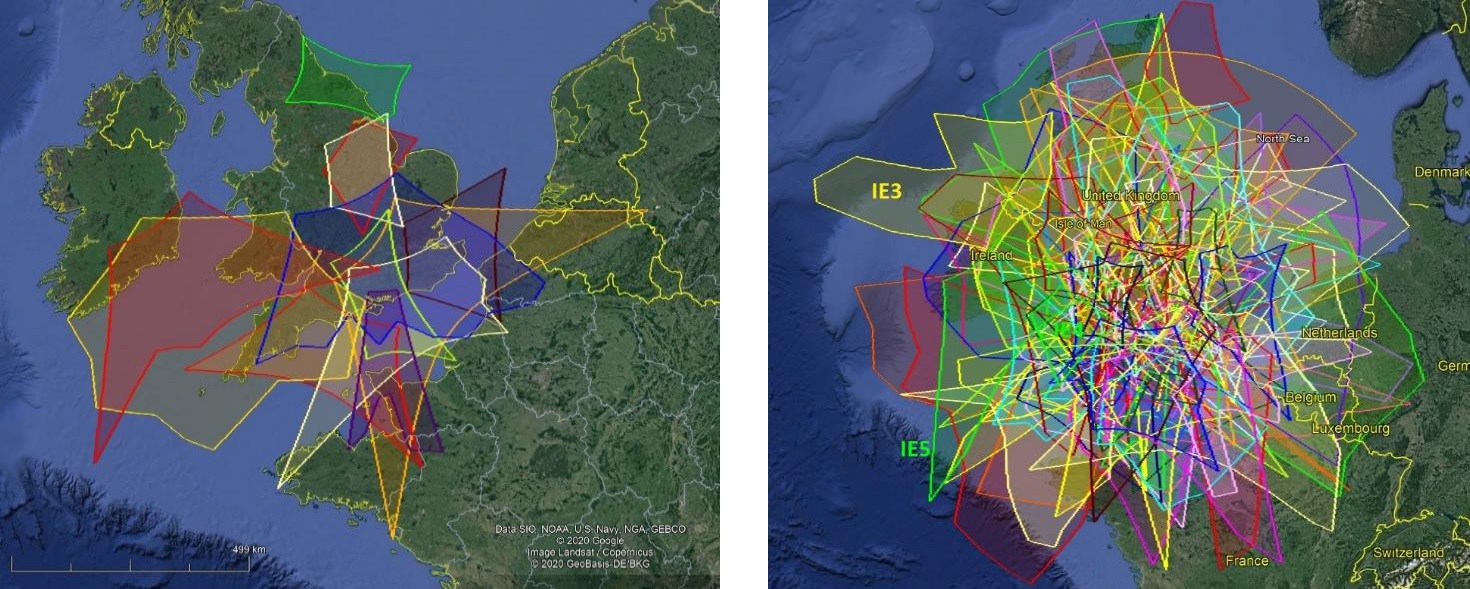
Figure 1 – GMN cameras installed in Ireland and the UK, left the coverage in October 2020, at right the coverage at the end of 2021.
Belgium and the Netherlands
Figure 2 shows the GMN coverage end 2021 for both countries. The number of RMS cameras remained at 11 in the Netherlands but increased from 4 to 10 in Belgium.
The map can be compared with the situation end October 2020 in the previous GMN status report (Roggemans, 2021). These 21 cameras were involved in 16486 multi-station events against 10141 events in 2020 with 15 cameras.
Most of the RMS cameras are being installed for the re-enforcement of the CAMS-BeNeLux network. For this purpose, the 6 mm and 8 mm lenses are preferred which have significant less distortion than the 3.6 mm. All cameras are pointed in function of an optimal geographic overlap. 2021 brought rather unfavorable weather for CAMS-BeNeLux, in addition to several CAMS camera stations being unavailable for various technical issues. In spite of these problems, 2021 had the second-best number of orbits in 10 years for CAMS-BeNeLux and this was thanks to the extra coverage created by the RMS cameras. More RMS cameras will be installed in 2022 to replace the Watec H2 Ultimate after several years of service.
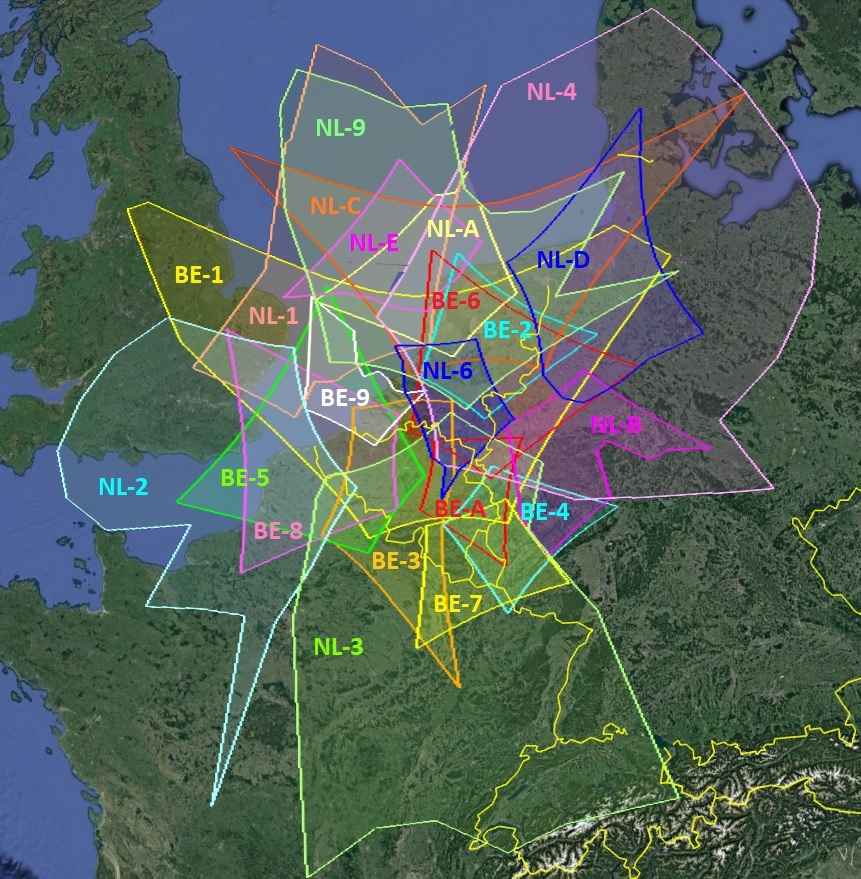
Figure 2 – GMN camera fields intersected at 100 km elevation, for 21 cameras installed in Belgium and the Netherlands. The letter code refers to the camera ID, e.g., NL-3 = NL0003.
France and Spain
The number of French RMS cameras increased from 10 to 14 and 1 camera quit providing data in 2021. The 14 French cameras were involved in 5652 multi-station events against 3195 events in 2020 with 10 cameras. The Southern and Western part of France remain still poorly covered (Figure 3).
A lot of progress was made in Spain where the number of RMS cameras increased from 8 to 23 in 2021. All 8 cameras from 2020 remained active. A separate map has been plotted with the camera overlap for Spain (Figure 4). The 23 Spanish cameras were involved in 15113 multi-station events against 1207 events in 2020 with 8 cameras.
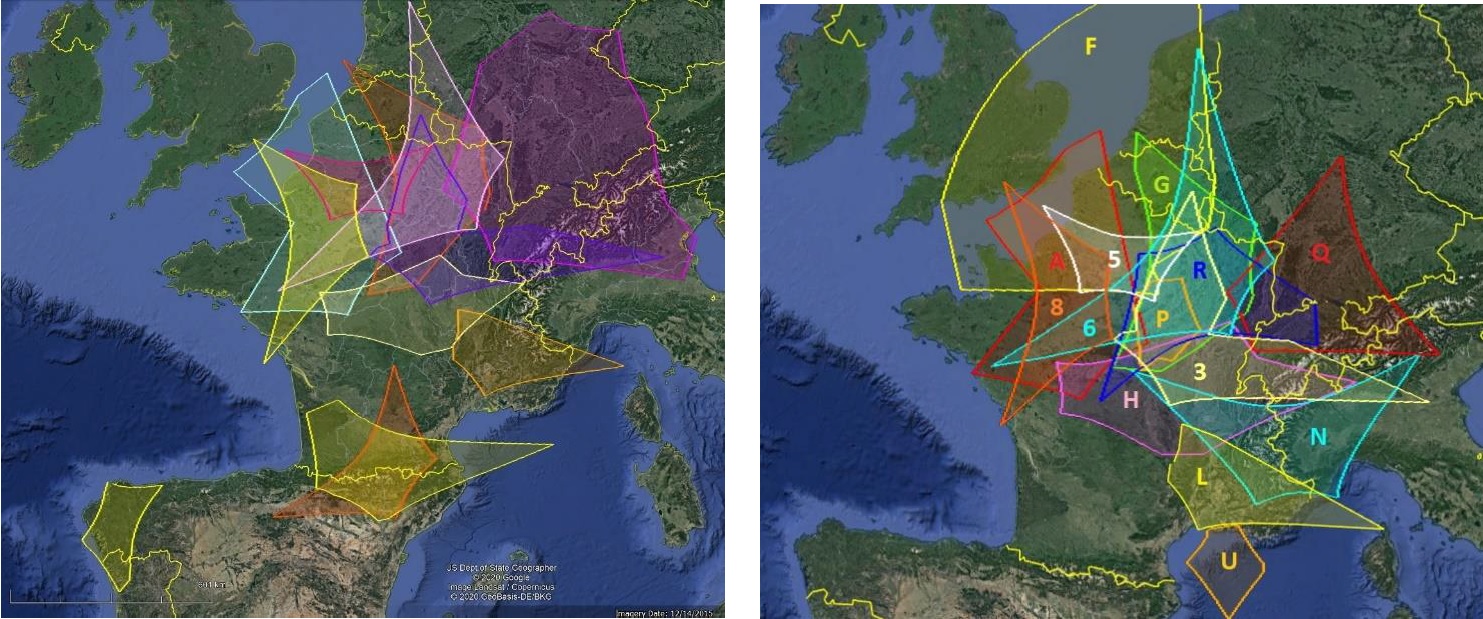
Figure 3 – GMN camera fields intersected at 100 km elevation, 2020 situation in France and Spain at left, in France in 2021 at right. The letter code refers to the camera ID, e.g., F = FR000F. The situation in Spain at the end of 2021 is shown in Figure 4.
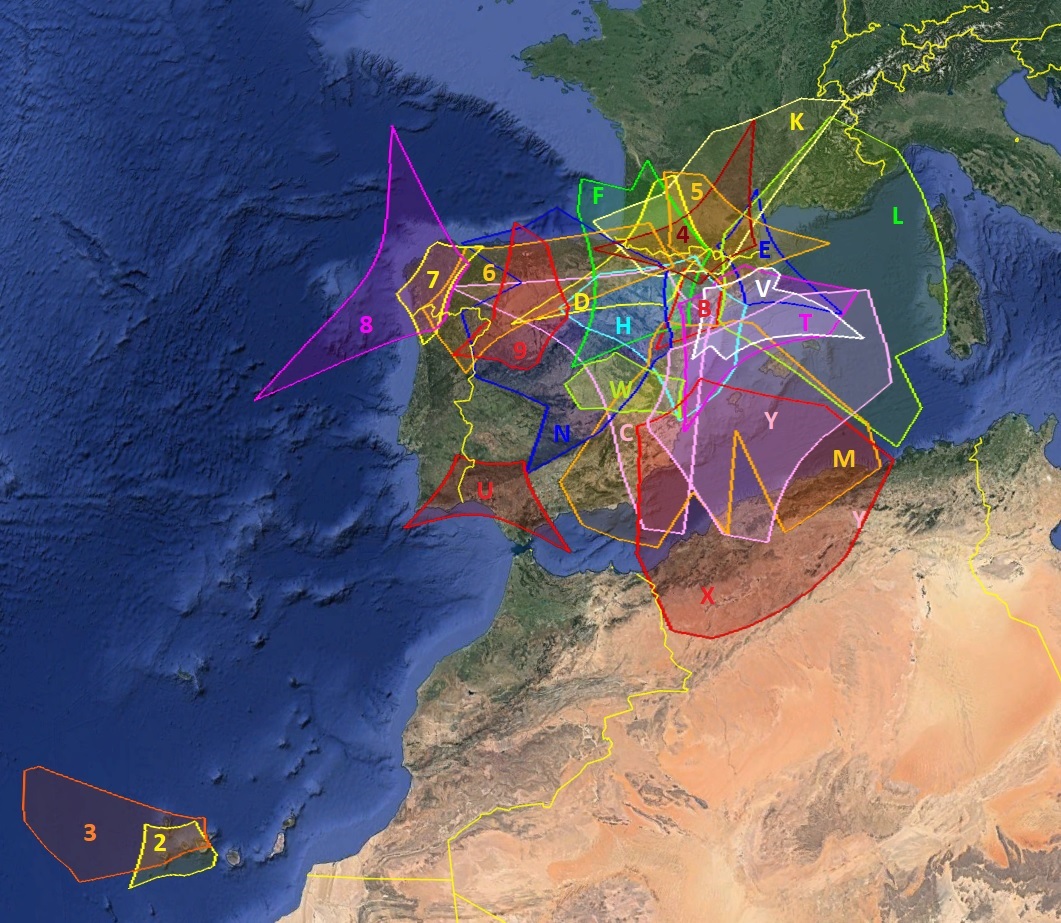
Figure 4 – GMN camera fields intersected at 100 km elevation, for 23 cameras installed in Spain. The letter code refers to the camera ID, e.g., M = ES000M.
Central Europe
In Germany two new cameras got their first orbits. The 12 German cameras were involved in 7136 multi-station events against 4152 events in 2020 with 10 cameras. Some cameras in the North-Western part of Germany were installed as part of the CAMS-BeNeLux network. The 4 Czech cameras were involved in 468 multi-station events against 170 events in 2020 with 3 cameras. The single Polish camera was involved in 67 multi-station events against 35 events in 2020. Slovakia got its first camera in 2021 with 37 paired meteors and Switzerland got one camera with 3 paired meteors in 2021.
Central Europe definitely needs more cameras and we hope that more amateurs get involved from the former networks that were participating in EDMOND. Figure 5 shows the current situation at the end of 2021.
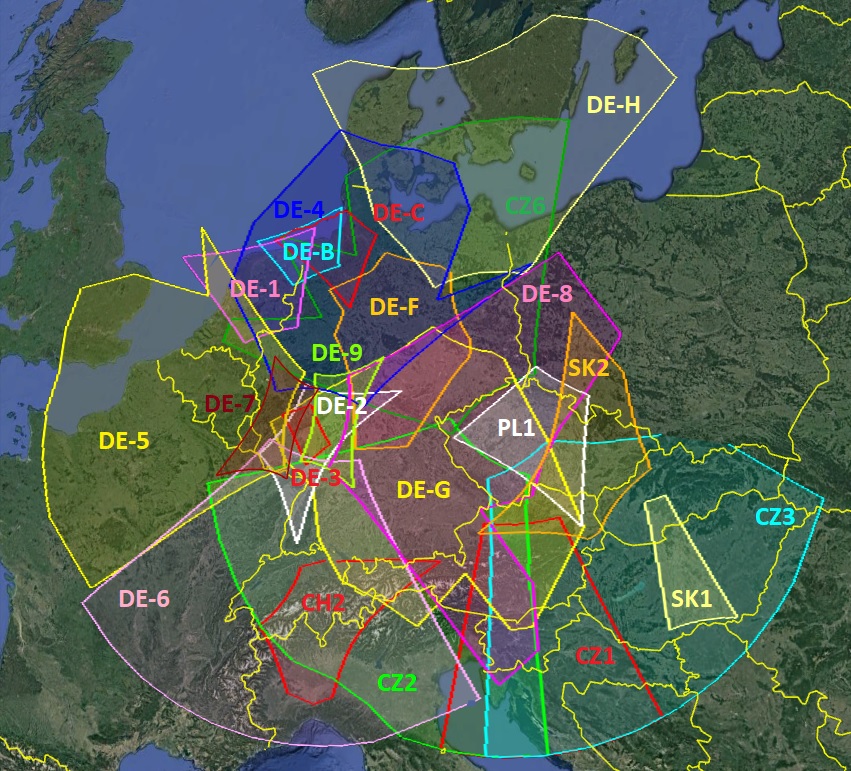
Figure 5 – GMN camera fields intersected at 100 km elevation, for cameras installed in Czechia, Germany, Poland, Slovakia and Switzerland. The letter code refers to the camera ID, e.g., CZ3 = CZ0003.
South-Eastern Europe
Croatia was the first European country in May 2019 to harvest orbits with three RMS cameras. By the end of 2019 Croatia had already 23 cameras successfully contributing in triangulations, good for 12221 multi-station events. The Croatian branch of GMN had 48 cameras in 2021 that were involved in 38650 multi-station events against 35275 events in 2020 with 32 cameras. Croatia plays a major role in the coordination of GMN, maintaining the IStream website, offering RMS cameras plug & play for sale and providing technical assistance to participants in the GMN project worldwide. The density of the camera field coverage barely permits to mention all the camera IDs (Figure 6). A number of Croatian cameras have a very small FoV to register fainter meteors with higher positional accuracy. For clarity, these camera fields are shown in close-up in Figure 7.
Slovenia had its first RMS contributing in August 2019 and got its second RMS in August 2021. The two cameras were involved in 6191 multi-station events against 4081 events in 2020 with a single camera. The number of RMS cameras in Italy increased from 1 to 5 and these cameras were involved in 5559 multi-station events against 5505 events in 2020 with a single camera. Bulgaria got its first 3 RMS cameras installed in 2021 of which two had 420 multi-station events.
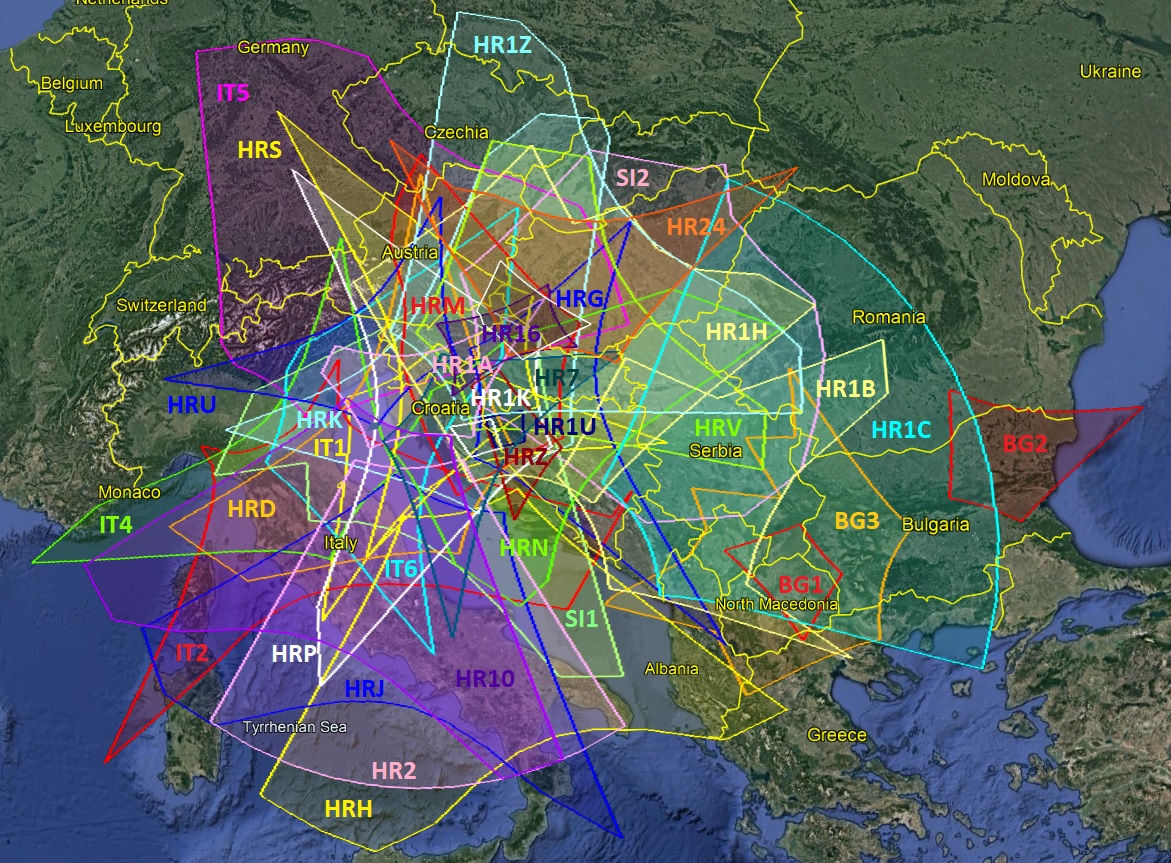
Figure 6 – GMN camera fields intersected at 100 km elevation, for cameras installed in Bulgaria, Croatia, Italy and Slovenia. The letter code refers to the camera ID, e.g., HRH = HR000H.
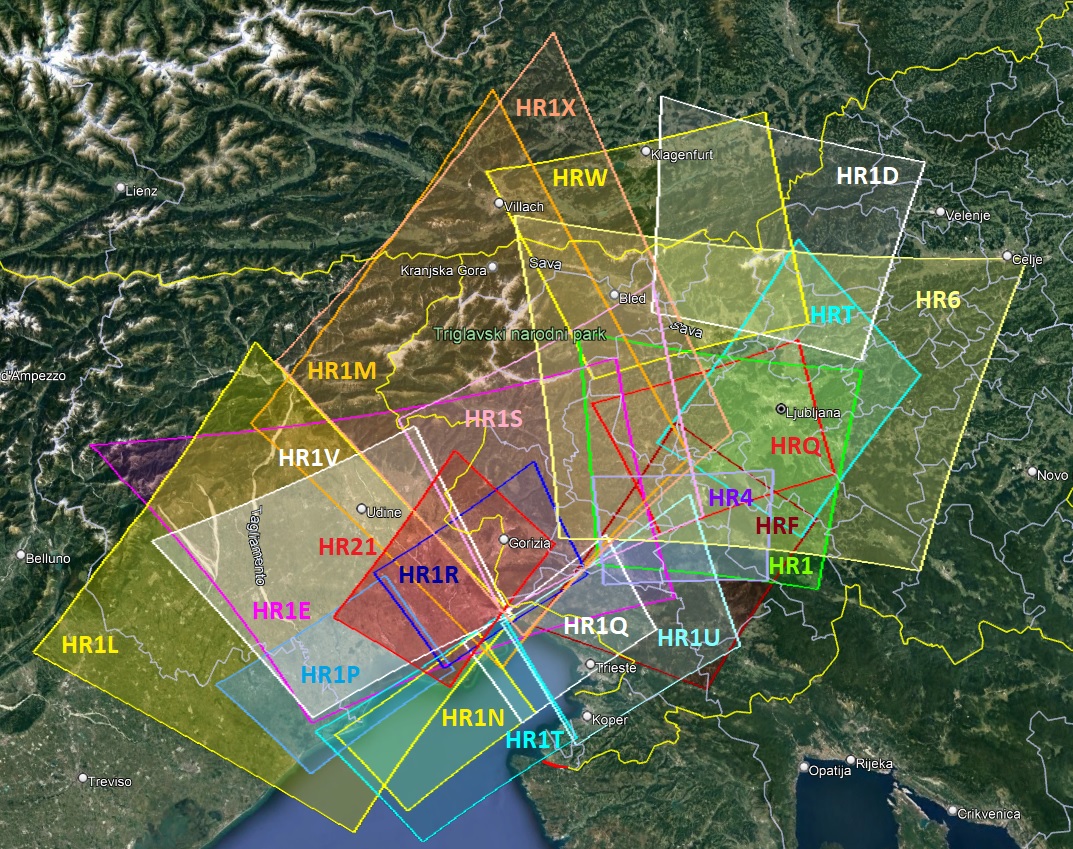
Figure 7 – Close-up for small GMN camera fields intersected at 100 km elevation, for cameras installed in Croatia.
Russia
The number of RMS cameras having paired meteors remained stable at 21 in Russia. With 6208 orbits in 2021 against 13438 in 2020. Dmitrii Rychkov explains that there were problems with the maintenance of some meteor stations, which reduced the number of paired observations. This should be solved in 2022. Some single RMS devices (Figure 8) got installed elsewhere in Russia, waiting for coverage from other RMS cameras at a suitable distance.
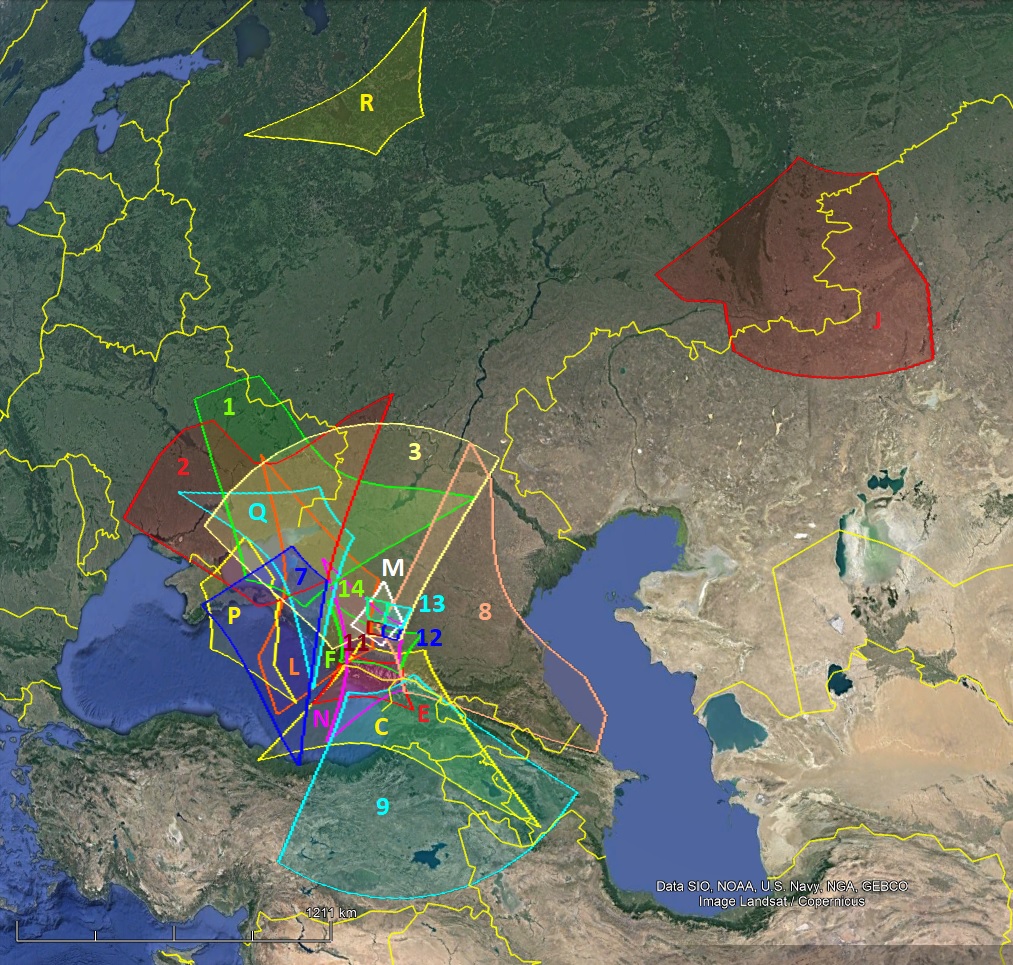
Figure 8 – GMN camera fields intersected at 100 km elevation, for cameras installed in Russia. The letter code refers to the camera ID, e.g., R = RU000R.
Overview picture of Europe
Plotting all the camera fields of Europe in a single map shows the concentrations of the network around the UK and around Croatia (Figure 9). Everything in between still needs more cameras to guard the atmosphere above Europe. Northern Europe is still completely missing as well as Eastern Europe.
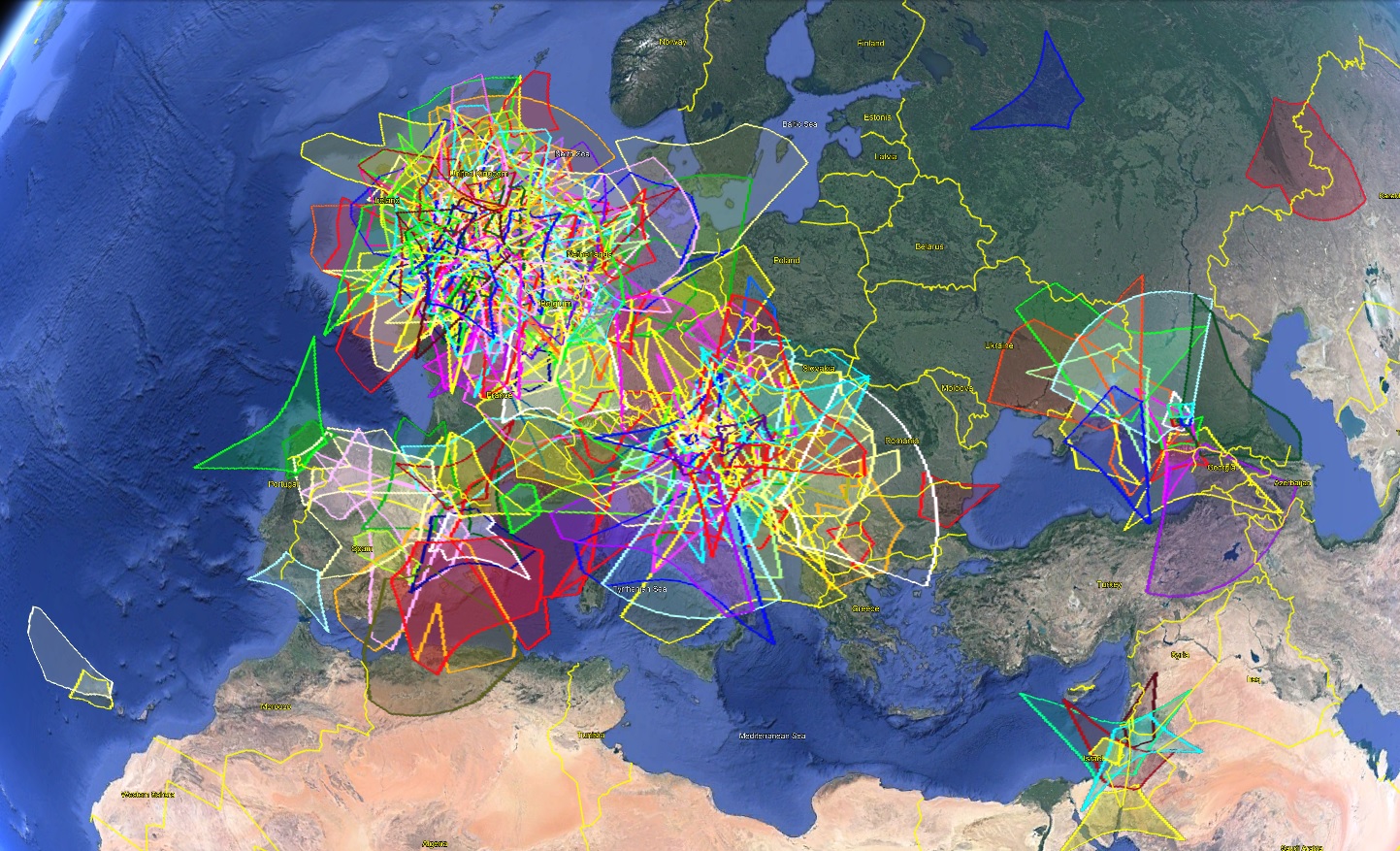
Figure 9 – GMN camera fields intersected at 100 km elevation, for 266 cameras installed in Europe and 6 in Israel.
Israel
GMN got some extra cameras in Israel where 2009 orbits were recorded by 6 cameras in 2021 against 553 orbits with 3 cameras in 2020 when the first cameras got operational in November. Some cameras are waiting for some extra overlap (Figure 10).
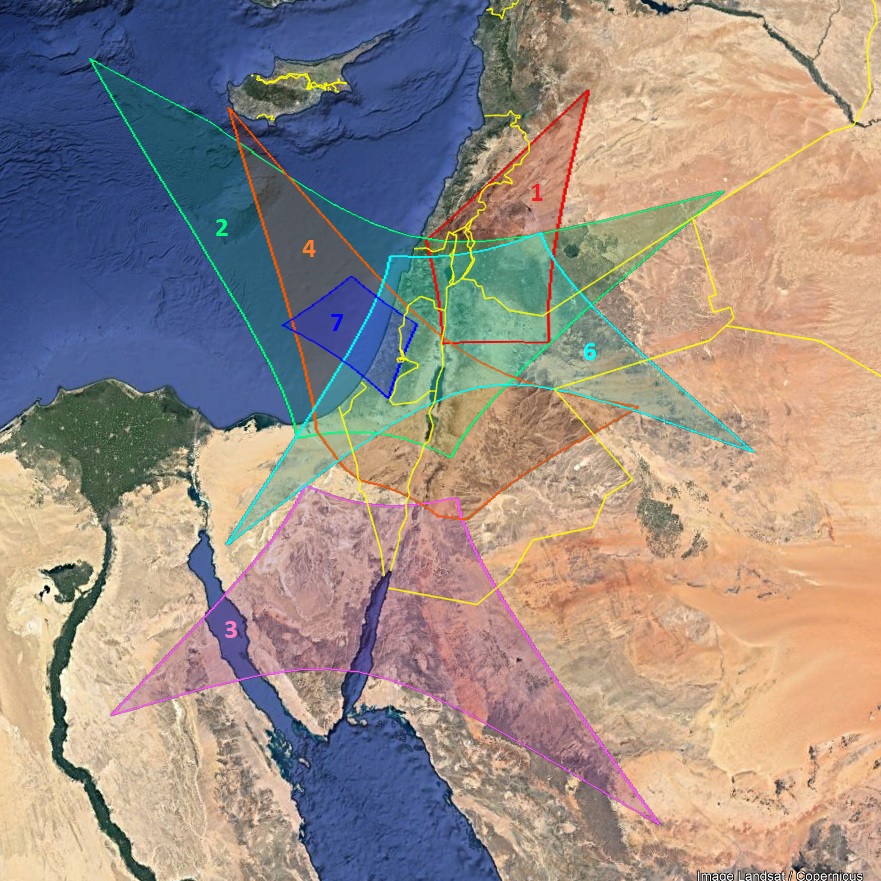
Figure 10 – GMN camera fields intersected at 100 km elevation, for cameras installed in Israel. The letter code refers to the camera ID, e.g., 3 = IL0003.
Brazil
The BRAMON network had its first two RMS cameras getting paired meteors in October 2020. The network expanded to 13 operational cameras, with 1645 orbits in 2021 against 40 orbits with two cameras in the last quarter of 2020. The cameras cover a huge amount of atmosphere and when more RMS get installed the number of multi-station hits will increase a lot at these strategic important southern latitudes.
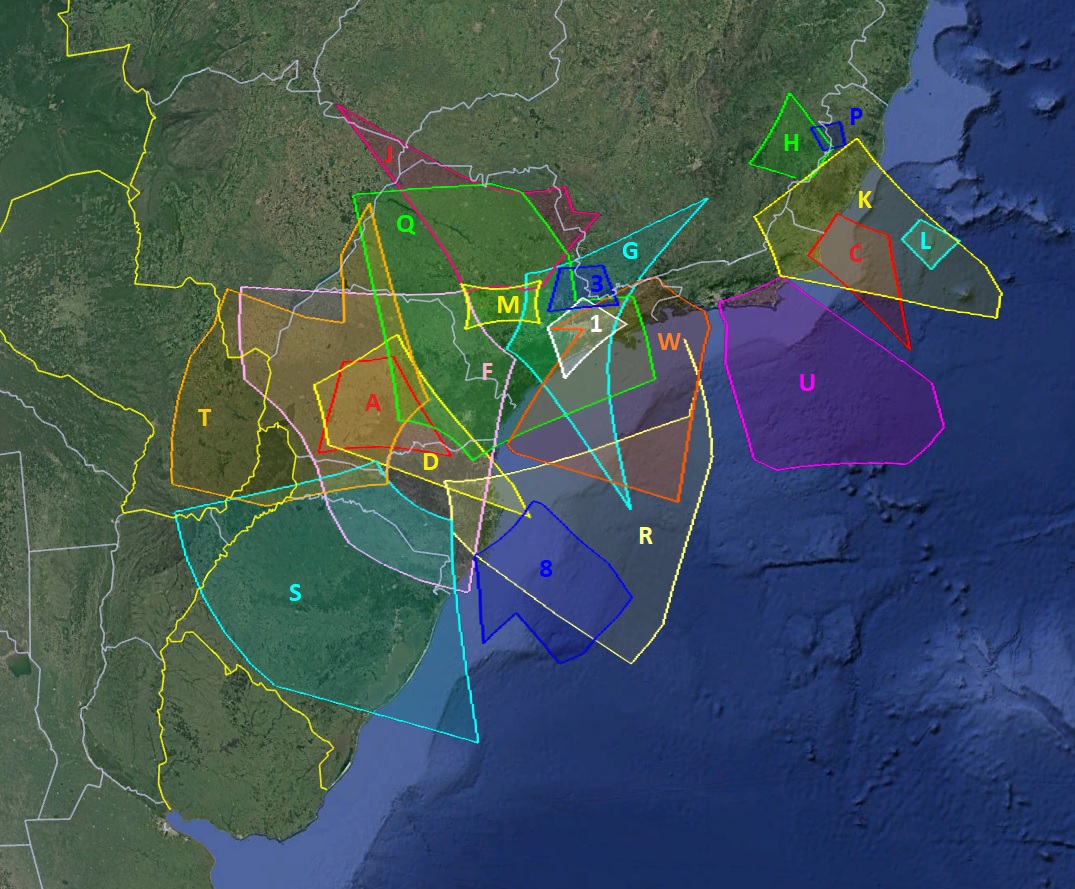
Figure 11 – GMN camera fields intersected at 100 km elevation, for cameras installed in Brazil. The letter code refers to the camera ID, e.g., S = BR000S.
Canada
The Canadian GMN network got its first 5 operational RMS cameras providing orbits in June 2019 and expanded to 11 cameras by the end of 2019 and 18 cameras at the end of 2020. During 2021, 15 new camera IDs appeared in the list with orbits while 4 former IDs disappeared. 8809 orbits were recorded with 29 cameras in 2021 against 10815 orbits in 2020 with 18 cameras. The reason for the decrease in multi-station hits may be due to the weather and technical issues.
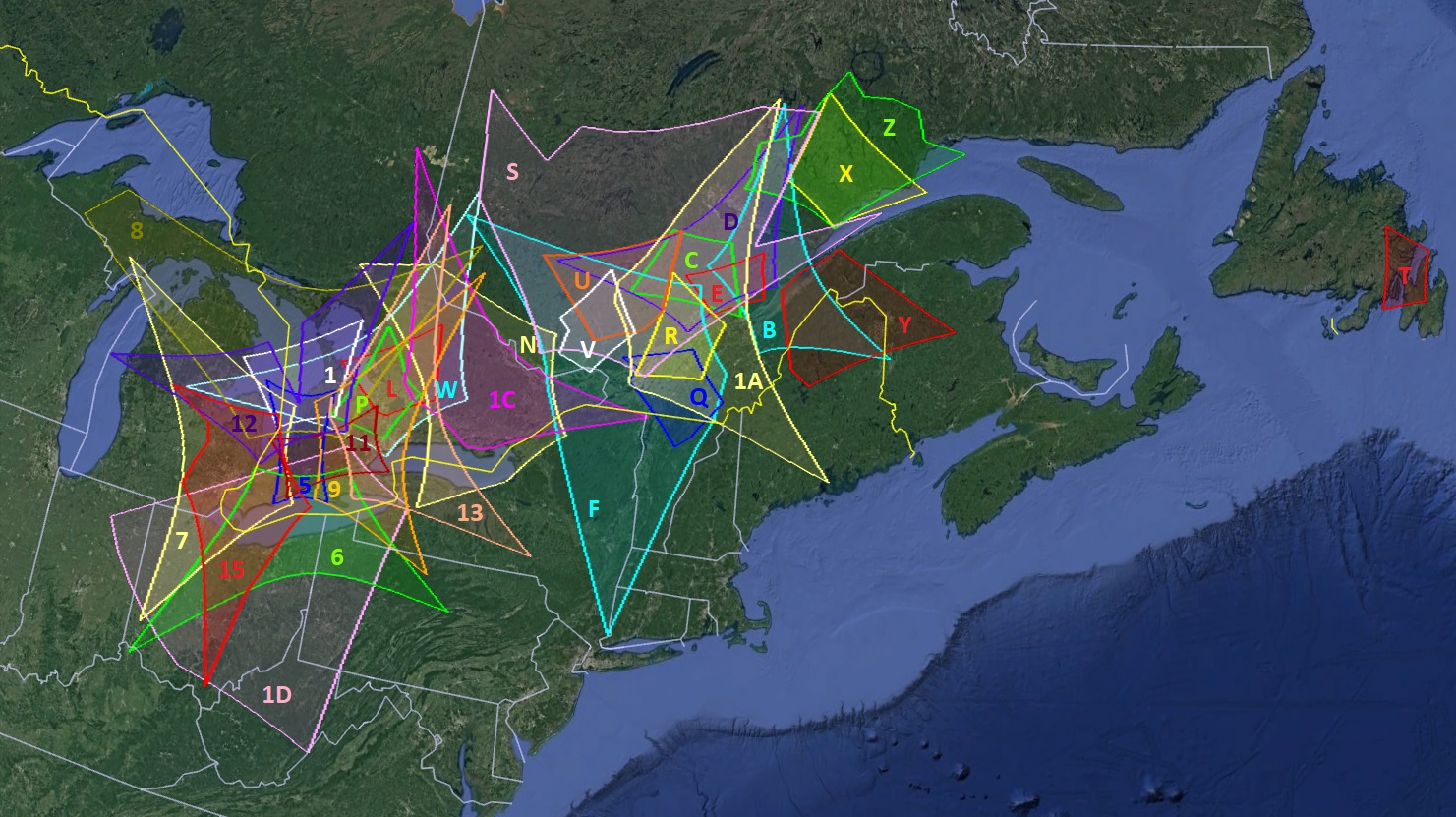
Figure 12 – GMN camera fields intersected at 100 km elevation, for cameras installed in Canada. The letter code refers to the camera ID, e.g., 1D = CA001D.
New Zealand
The first 88 orbits for the RMS cameras in New Zealand were recorded in July 2021. Two camera fields are waiting to get coverage from other RMS cameras (Figure 13). In total 1146 orbits were collected in 2021. The strategic position of New Zealand is most important to collect orbits from the Southern hemisphere at these poorly covered longitudes.
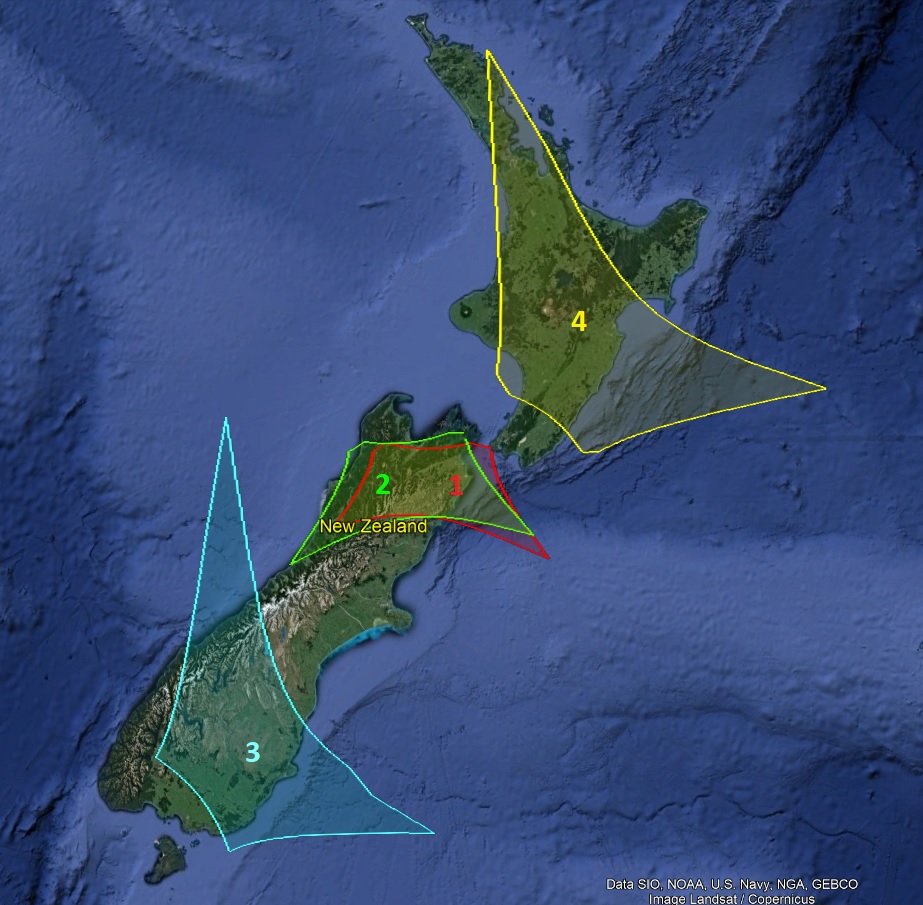
Figure 13 – GMN camera fields intersected at 100 km elevation, for cameras installed in New Zealand. The letter code refers to the camera ID, e.g., 3 = NZ0003.
Malaysia
A first RMS has been installed in Malaysia waiting for coverage from cameras installed at a suitable distance to get good triangulations (Figure 14). A meteor camera network in this part of the world would be the first as far as known. Close to the equator at this longitude such camera network would help to monitor meteor activity at these poorly covered longitudes.
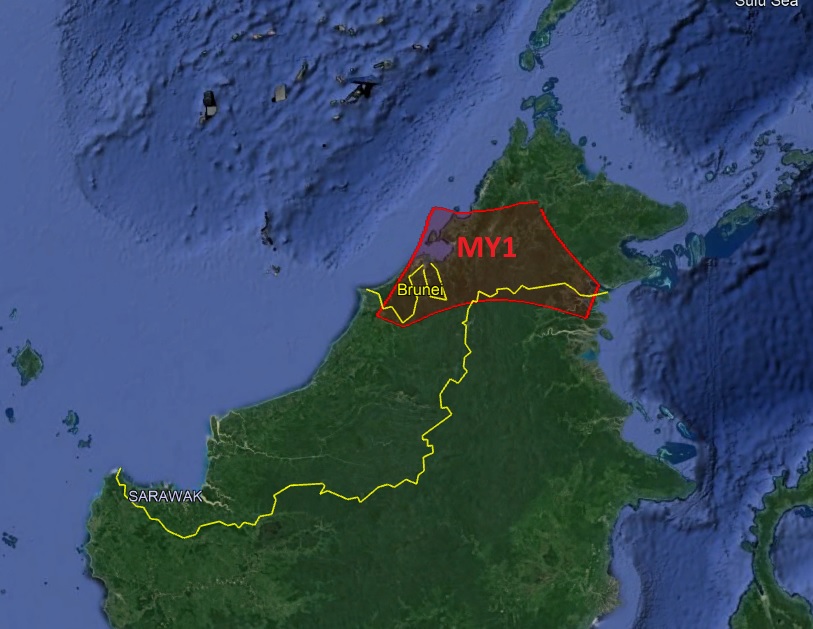
Figure 14 – GMN camera field intersected at 100 km elevation, for the first camera installed in Malaysia. The letter code refers to the camera ID, e.g., 1 = MY0001.
Australia
The first 31 meteor orbits by Australian RMS cameras were registered in September 2021 when the first 5 cameras got ready to harvest meteors. By the end of 2021 already 12 cameras managed to obtain orbits (Figure 15). In December 2021 Australian cameras collected 937 orbits, resulting in 1871 orbits in the final 4 months of 2021.
Past visual observations in Australia often enjoyed most favorable weather conditions, a situation which has been confirmed by the Australian CAMS network in West Australia. No doubt that Australia will become a major supplier of orbit data to GMN.
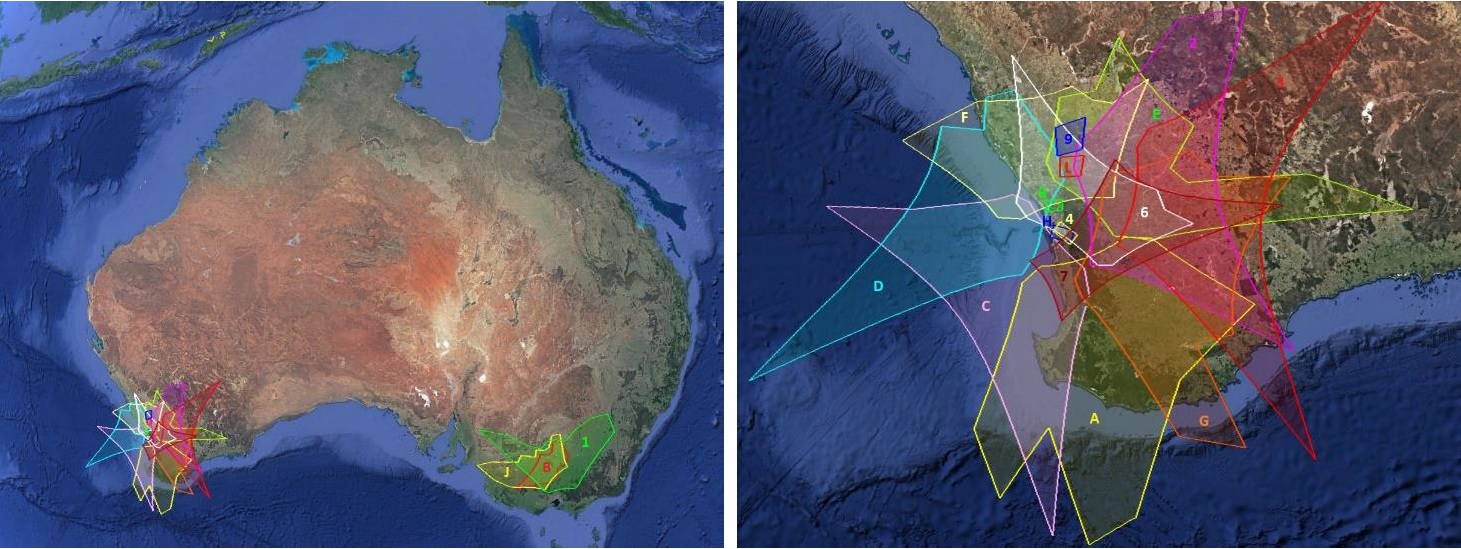
Figure 15 – GMN camera fields intersected at 100 km elevation, for cameras installed in Australia, global view at left and a close up for West Australia at right. The letter code refers to the camera ID, e.g., 1 = AU0001.
USA
The American New Mexico Meteor Array was the pioneering network of the GMN as it started to harvest meteors in December 2018 with 6 cameras, good for 497 orbits. It remained the only data provider for GMN until May 2019 when the first 3 Croatian cameras started to deliver orbits. At the end of 2019, the number of US cameras had increased to 20 collecting 27643 orbits in 2019.
Figure 16 at left shows the GMN status like it was end of October 2020 with 24 RMS cameras in the US. The expansion of the network shown at right is impressive. The 36 RMS cameras of the Lowell Observatory and those in New Mexico and California have significant overlap if we compare the camera fields of the Lowell Observatory in Figure 18 with the other US camera fields in the same region shown in Figure 17.

Figure 16 – GMN camera fields intersected at 100 km elevation, for cameras installed in the USA. At left the situation like it was by end October 2020, at right all US camera fields at the end of 2021. The letter code refers to the camera ID, e.g., 1U = US001U.
In December 2020 the Lowell CAMS team at Lowell Observatory, Arizona, added 9 RMS cameras to their CAMS network and another 14 RMS cameras got installed elsewhere in the US. The 33 operational cameras in the US collected as many as 50607 orbits in 2020. The Lowell team added another 27 RMS cameras to their CAMS network in 2021 and 12 cameras got installed in California and elsewhere in the US. With 72 RMS cameras registering paired meteors in the US, a total of 91901 orbits got obtained, 51425 of them had RMS cameras of the Lowell Observatory involved. Without the important contribution by the Lowell RMS cameras, the total number of orbits for the US in 2021 would have been less. The implementation of RMS cameras in the Arizona CAMS network has been a win-win for both projects, CAMS and GMN. RMS cameras proved to be a perfect alternative for the more expensive Watecs since RMS cameras were successfully integrated in the CAMS-BeNeLux network in 2019.
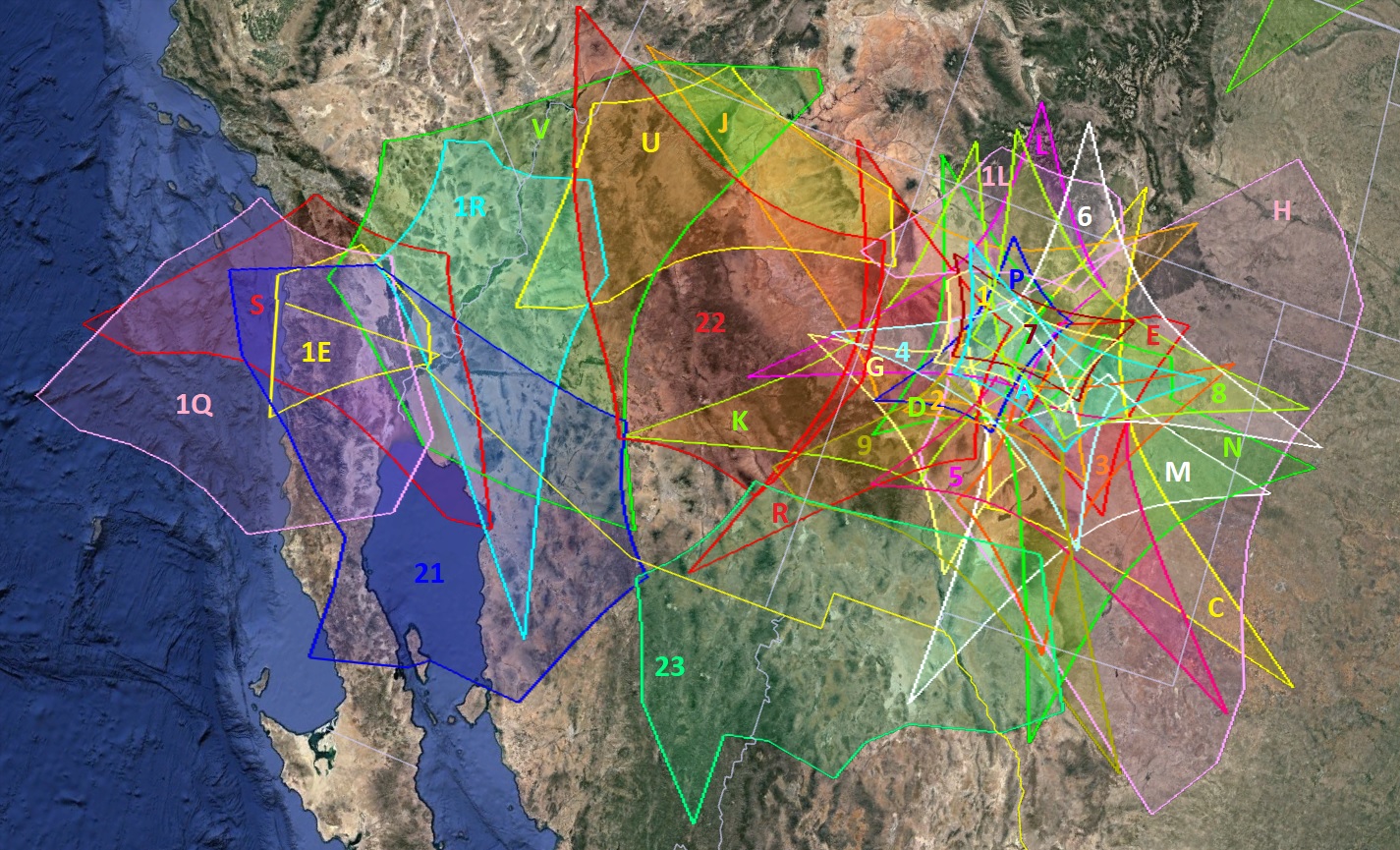
Figure 17 – GMN camera fields intersected at 100 km elevation, for cameras installed in the US, close up for the NMMA. The letter code refers to the camera ID, e.g., M = US000M.
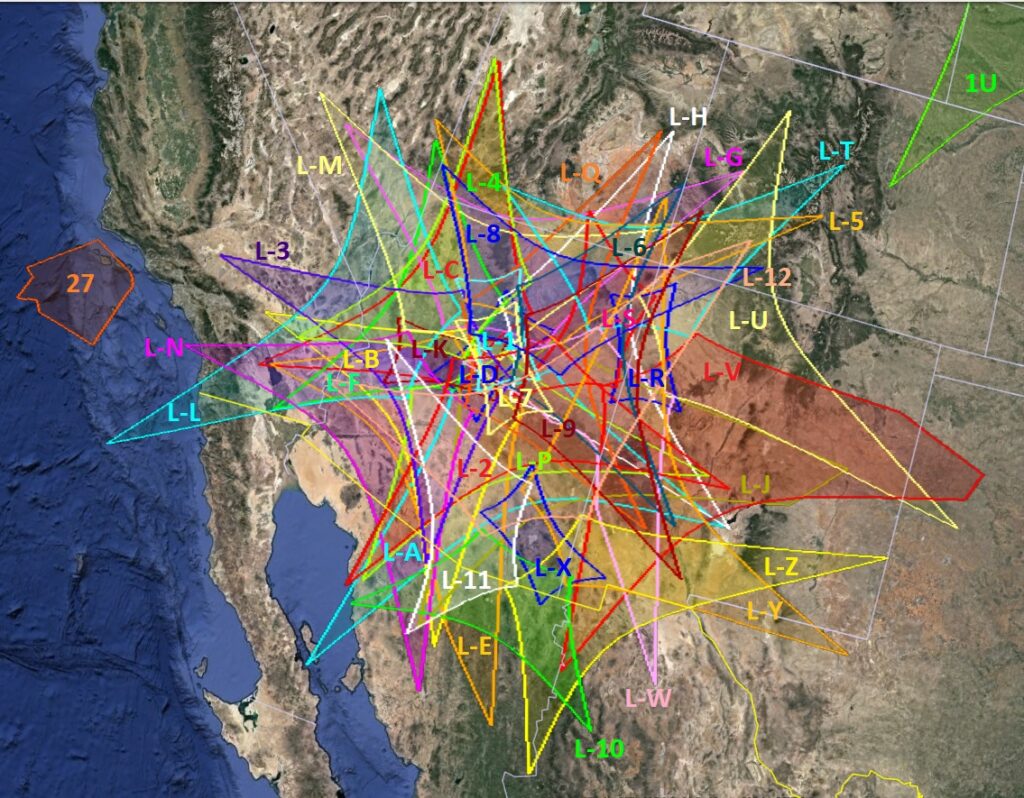
Figure 18 – GMN camera fields intersected at 100 km elevation, for cameras installed in the US, close up for the Lowell network in Arizona. The letter code refers to the camera ID, e.g., L-T = USL00T.
It is worthwhile mentioning that all RMS camera IDs that got installed and contributing in orbits in the US remained in service. Having many cameras is nice, to keep them all functioning is a challenge and requires care and maintenance.
Some lonely, newly installed RMS cameras wait for partners at a suitable distance for triangulations. Cameras installed in the North-East of the US can easily connect to the Canadian branch of the GMN. The GMN output delivers UFO-Capture output and simply adding a CAMS ID in the config file is sufficient to obtain CAMS compatible output. This makes the GMN concept of particular interest for existing networks.
GMN statistics 2021
When a first GMN status report got published, including all data until end October 2020, 140 operational cameras were involved and 144950 orbits had been collected (Roggemans, 2021). Meanwhile, 14 months later, we can compare 3 years of GMN work.
Figure 19 shows the accumulated number of orbits obtained and the number of contributing cameras during each calendar month. The rapid growth of the network can be seen from the increment in numbers of orbits with time. The number of cameras involved in GMN increased rapidly during 2021 while the number of orbits did not increase at the same pace. In spite of many more cameras and a lot more atmosphere covered, the gain in number of orbits is not proportional to the increased capacity of the network. It looks like the weather has been less favorable than previous years worldwide. The details per month for the number of orbits is given in Table 1. The number of cameras is given in Table 2. With many more cameras installed but not yet contributing, it is a matter of getting enough clear sky. Whenever some unexpected meteor activity occurs, the Global Meteor Network has good chances to cover it.
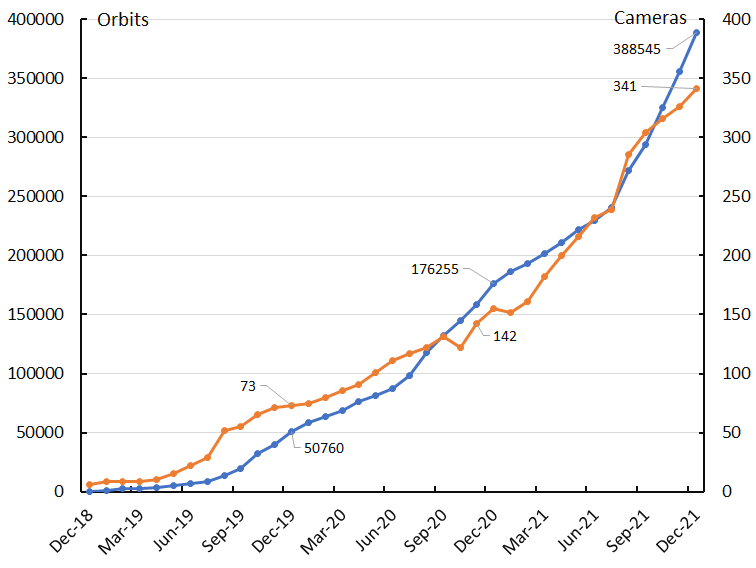
Figure 19 – The accumulated number of orbits (blue) and the actual number of operational cameras involved in triangulations (orange). The numbers at the end of each year are indicated.
Table 1 – Total number of orbits obtained by the Global Meteor Network cameras per calendar month.
| Month | 2018 | 2019 | 2020 | 2021 | Total |
| 01 | – | 564 | 7539 | 9919 | 18022 |
| 02 | – | 1284 | 5330 | 6567 | 13181 |
| 03 | – | 537 | 5101 | 8829 | 14467 |
| 04 | – | 876 | 7248 | 9655 | 17779 |
| 05 | – | 1242 | 5698 | 10268 | 17208 |
| 06 | – | 1523 | 5738 | 8020 | 15281 |
| 07 | – | 1961 | 10973 | 11325 | 24259 |
| 08 | – | 5387 | 19422 | 31296 | 56105 |
| 09 | – | 6058 | 14258 | 21435 | 41751 |
| 10 | – | 11978 | 13097 | 31503 | 56578 |
| 11 | – | 7710 | 13228 | 30414 | 51352 |
| 12 | 497 | 11143 | 17863 | 33059 | 62562 |
| Totals | 497 | 50263 | 125495 | 212290 | 388545 |
At the end of 2021 the Global Meteor Network had cameras providing orbits in 22 different countries. Table 3 lists the number of multi-station events per country. For countries without cross-border triangulations this number is the same as the number of orbits recorded by these cameras, which is the case for Australia, Brazil, Israel, New Zealand and Russia. All other countries had meteors paired with cameras in neighboring countries. Therefore, we speak about multi-station events instead of orbits. For instance, an orbit obtained by cameras in Belgium, Germany, France, the Netherlands and the United Kingdom will be counted as 5 multi-station events, one for each country, regardless the number of cameras that contributed to it in each country. 27436 multi-station events recorded from the UK means that cameras in the UK contributed in the triangulation of 27436 orbits.
Table 2 – Total number of operational cameras within the Global Meteor Network per calendar month.
| Month | 2018 | 2019 | 2020 | 2021 | Total |
| 01 | – | 9 | 75 | 152 | 165 |
| 02 | – | 9 | 80 | 161 | 174 |
| 03 | – | 9 | 86 | 182 | 196 |
| 04 | – | 10 | 91 | 200 | 220 |
| 05 | – | 15 | 101 | 216 | 234 |
| 06 | – | 22 | 111 | 232 | 256 |
| 07 | – | 29 | 117 | 239 | 264 |
| 08 | – | 52 | 122 | 285 | 303 |
| 09 | – | 55 | 131 | 304 | 327 |
| 10 | – | 65 | 122 | 316 | 341 |
| 11 | – | 71 | 142 | 326 | 356 |
| 12 | 6 | 73 | 155 | 341 | 375 |
Table 3 – Total number of multi-station events recorded in each country for each year.
| 2018 | 2019 | 2020 | 2021 | Total | |
| AU | – | – | – | 1871 | 1871 |
| BE | – | 921 | 5705 | 8751 | 15377 |
| BG | – | – | – | 420 | 420 |
| BR | – | – | 40 | 1645 | 1685 |
| CA | – | 3599 | 10815 | 8809 | 23223 |
| CH | – | – | – | 3 | 3 |
| CZ | – | – | 170 | 468 | 638 |
| DE | – | 200 | 4152 | 7136 | 11488 |
| ES | – | – | 1207 | 15113 | 16320 |
| FR | – | – | 3195 | 5652 | 8847 |
| HR | – | 12221 | 35275 | 38650 | 86146 |
| IE | – | – | 120 | 424 | 544 |
| IL | – | – | 553 | 2009 | 2562 |
| IT | – | 862 | 5505 | 5559 | 11926 |
| NL | – | 278 | 4436 | 7735 | 12449 |
| NZ | – | – | – | 1146 | 1146 |
| PL | – | – | 35 | 67 | 102 |
| RU | – | 5715 | 13438 | 6208 | 25361 |
| SI | – | 2753 | 4081 | 6191 | 13025 |
| SK | – | – | – | 37 | 37 |
| UK | – | – | 1889 | 27436 | 29325 |
| US | 497 | 27643 | 50607 | 91901 | 170648 |
Table 4 – Total number of cameras in each country for each year.
| RMS | 2018 | 2019 | 2020 | 2021 | Total |
| AU | – | – | – | 12 | 12 |
| BE | – | 4 | 4 | 10 | 10 |
| BG | – | – | – | 2 | 2 |
| BR | – | – | 2 | 13 | 13 |
| CA | – | 11 | 18 | 29 | 33 |
| CH | – | – | – | 1 | 1 |
| CZ | – | – | 3 | 4 | 4 |
| DE | – | 4 | 10 | 12 | 13 |
| ES | – | – | 8 | 23 | 23 |
| FR | – | – | 10 | 14 | 15 |
| HR | – | 23 | 32 | 48 | 51 |
| IE | – | – | 2 | 3 | 3 |
| IL | – | – | 3 | 6 | 6 |
| IT | – | 1 | 1 | 5 | 5 |
| NL | – | 2 | 11 | 11 | 12 |
| NZ | – | – | – | 2 | 2 |
| PL | – | – | 1 | 1 | 1 |
| RU | – | 10 | 21 | 21 | 22 |
| SI | – | 1 | 1 | 2 | 2 |
| SK | – | – | – | 1 | 1 |
| UK | – | – | 13 | 97 | 97 |
| US | 6 | 20 | 33 | 72 | 72 |
| Total | 6 | 76 | 173 | 389 | 400 |
Meteor showers covered by GMN
Using the Working List of Meteor Showers (Jenniskens et al., 2020; Jopek and Kaňuchová, 2017; Jopek and Jenniskens, 2011; Neslušan et al., 2020) as a reference, 411 of the showers listed could be associated with orbits collected by the Global Meteor Network. The number of orbits recorded for each of these showers is listed in Table 5 for each year since 2018.
The GMN meteor shower association has been based on the table of Sun-centered ecliptic shower radiant positions given in Jenniskens et al. (2018). 654 entrees of the Working List of Meteor Showers have no matching orbits in the GMN database yet. Some of the showers are periodic and display only some activity once every few years, some showers have been detected only by radar in a fainter range of magnitudes than what GMN cameras cover and others are known as daylight meteor showers. While GMN is getting better coverage at the southern hemisphere, more of the low declination meteor showers will get covered. For a number of listed meteor showers their absence in the GMN orbit database may be explained because the evidence for the existence of the shower could be missing. One of the goals of the GMN project is to help to identify ghost meteor showers that should be removed from the Working List.
Table 5 serves as an inventory of what the GMN orbit database has available until end 2021. Of course, the number of shower members detected depends on the criteria used to associate a meteor with a known meteor shower radiant. The GMN shower association criterion assumes that meteors within 1° in solar longitude, within 3° in radiant, and within 10% in geocentric velocity of a shower reference location are members of that shower. Further details about the shower association are explained in Moorhead et al. (2020). This is a rather strict criterion since meteor showers often have a larger dispersion in radiant position and velocity. Therefore, using the orbit similarity criteria (Drummond, 1981; Southworth and Hawkins, 1963; Jopek, 1993) will certainly detect more shower candidates but at the risk of including sporadic orbits that fulfil similarity criteria by pure chance.
Table 5 – Total number of orbits according to the meteor shower association (IAU number + code) for each year.
| IAUNo | Code | Shower | 2018 | 2019 | 2020 | 2021 | Total |
| SPO | Sporadics | 188 | 27834 | 71462 | 116282 | 215766 | |
| 1 | CAP | alpha Capricornids | 0 | 139 | 793 | 641 | 1573 |
| 2 | STA | Southern Taurids | 0 | 1388 | 1650 | 3421 | 6459 |
| 3 | SIA | Southern iota Aquariids | 0 | 25 | 53 | 61 | 139 |
| 4 | GEM | Geminids | 200 | 2664 | 7310 | 12163 | 22337 |
| 5 | SDA | Southern delta Aquariids | 0 | 350 | 1560 | 1570 | 3480 |
| 6 | LYR | April Lyrids | 0 | 46 | 733 | 1044 | 1823 |
| 7 | PER | Perseids | 0 | 1809 | 8615 | 14719 | 25143 |
| 8 | ORI | Orionids | 0 | 2771 | 3423 | 6905 | 13099 |
| 9 | DRA | October Draconids | 0 | 4 | 3 | 10 | 17 |
| 10 | QUA | Quadrantids | 3 | 139 | 919 | 1710 | 2771 |
| 11 | EVI | eta Virginids | 0 | 5 | 102 | 424 | 531 |
| 12 | KCG | kappa Cygnids | 0 | 51 | 237 | 2559 | 2847 |
| 13 | LEO | Leonids | 0 | 426 | 912 | 1598 | 2936 |
| 15 | URS | Ursids | 5 | 134 | 336 | 259 | 734 |
| 16 | HYD | sigma Hydrids | 7 | 557 | 779 | 2116 | 3459 |
| 17 | NTA | Northern Taurids | 1 | 963 | 1336 | 2477 | 4777 |
| 18 | AND | Andromedids | 0 | 61 | 126 | 1034 | 1221 |
| 19 | MON | December Monocerotids | 12 | 184 | 330 | 791 | 1317 |
| 20 | COM | Comae erenicids | 17 | 367 | 767 | 925 | 2076 |
| 21 | AVB | alpha Virginids | 0 | 15 | 156 | 194 | 365 |
| 22 | LMI | Leonis Minorids | 0 | 109 | 134 | 269 | 512 |
| 23 | EGE | epsilon Geminids | 0 | 168 | 198 | 598 | 964 |
| 25 | NOA | Northern October delta Arietids | 0 | 145 | 170 | 234 | 549 |
| 26 | NDA | Northern delta Aquariids | 0 | 203 | 687 | 905 | 1795 |
| 27 | KSE | kappa Serpentids | 0 | 3 | 17 | 45 | 65 |
| 28 | SOA | Southern October delta Arietids | 0 | 180 | 324 | 663 | 1167 |
| 31 | ETA | eta Aquariids | 0 | 218 | 654 | 1608 | 2480 |
| 33 | NIA | Northern iota Aquariids | 0 | 108 | 188 | 299 | 595 |
| 40 | ZCY | zeta Cygnids | 0 | 32 | 362 | 607 | 1001 |
| 47 | DLI | mu Virginids | 0 | 7 | 99 | 73 | 179 |
| 61 | TAH | tau Herculids | 0 | 0 | 0 | 1 | 1 |
| 65 | GDE | gamma Delphinids | 0 | 1 | 6 | 22 | 29 |
| 69 | SSG | Southern mu Sagittariids | 0 | 31 | 87 | 113 | 231 |
| 81 | SLY | September Lyncids | 0 | 15 | 99 | 149 | 263 |
| 88 | ODR | omicron Draconids | 0 | 4 | 20 | 21 | 45 |
| 89 | PVI | January pi Virginids | 0 | 1 | 41 | 114 | 156 |
| 96 | NCC | Northern delta Cancrids | 1 | 45 | 154 | 197 | 397 |
| 97 | SCC | Southern delta Cancrids | 1 | 81 | 223 | 227 | 532 |
| 101 | PIH | pi Hydrids | 0 | 152 | 272 | 533 | 957 |
| 110 | AAN | alpha Antliids | 0 | 3 | 26 | 19 | 48 |
| 145 | ELY | eta Lyrids | 0 | 10 | 64 | 202 | 276 |
| 149 | NOP | Northern May Ophiuchids | 0 | 7 | 25 | 23 | 55 |
| 150 | SOP | Southern May Ophiuchids | 0 | 3 | 22 | 45 | 70 |
| 151 | EAU | epsilon Aquilids | 0 | 15 | 71 | 75 | 161 |
| 152 | NOC | Northern Daytime omega Cetids | 0 | 2 | 4 | 7 | 13 |
| 161 | SSC | Southern omega Scorpiids | 0 | 9 | 5 | 27 | 41 |
| 164 | NZC | Northern June Aquilids | 0 | 143 | 605 | 617 | 1365 |
| 165 | SZC | Southern June Aquilids | 0 | 32 | 108 | 131 | 271 |
| 170 | JBO | June Bootids | 0 | 0 | 5 | 3 | 8 |
| 171 | ARI | Daytime Arietids | 0 | 6 | 19 | 34 | 59 |
| 175 | JPE | July Pegasids | 0 | 43 | 254 | 351 | 648 |
| 176 | PHE | July Phoenicids | 0 | 2 | 1 | 24 | 27 |
| 182 | OCY | omicron Cygnids | 0 | 1 | 19 | 19 | 39 |
| 183 | PAU | Piscis Austrinids | 0 | 9 | 55 | 73 | 137 |
| 184 | GDR | July gamma Draconids | 0 | 10 | 140 | 84 | 234 |
| 186 | EUM | epsilon Ursae Majorids | 0 | 1 | 12 | 5 | 18 |
| 187 | PCA | psi Cassiopeiids | 0 | 11 | 45 | 63 | 119 |
| 188 | XRI | Daytime xi Orionids | 0 | 0 | 1 | 0 | 1 |
| 190 | BPE | beta Perseids | 0 | 11 | 52 | 60 | 123 |
| 191 | ERI | eta Eridanids | 0 | 88 | 232 | 321 | 641 |
| 194 | UCE | upsilon Cetids | 0 | 51 | 109 | 169 | 329 |
| 195 | BIN | beta Indids | 0 | 0 | 1 | 6 | 7 |
| 197 | AUD | August Draconids | 0 | 176 | 464 | 586 | 1226 |
| 206 | AUR | Aurigids | 0 | 58 | 152 | 263 | 473 |
| 208 | SPE | September epsilon Perseids | 0 | 196 | 426 | 814 | 1436 |
| 210 | BAU | beta Aurigids | 0 | 84 | 275 | 304 | 663 |
| 212 | KLE | Daytime kappa Leonids | 0 | 2 | 4 | 10 | 16 |
| 215 | NPI | Northern delta Piscids | 0 | 71 | 121 | 138 | 330 |
| 216 | SPI | Southern delta Piscids | 0 | 20 | 49 | 38 | 107 |
| 220 | NDR | nu Draconids | 0 | 39 | 124 | 127 | 290 |
| 221 | DSX | Daytime Sextantids | 0 | 7 | 4 | 27 | 38 |
| 225 | SOR | sigma Orionids | 0 | 71 | 114 | 228 | 413 |
| 242 | XDR | xi Draconids | 0 | 33 | 60 | 166 | 259 |
| 243 | ZCN | zeta Cancrids | 0 | 2 | 2 | 13 | 17 |
| 245 | NHD | November Hydrids | 0 | 13 | 39 | 127 | 179 |
| 246 | AMO | alpha Monocerotids | 0 | 25 | 30 | 41 | 96 |
| 250 | NOO | November Orionids | 1 | 396 | 489 | 1340 | 2226 |
| 252 | ALY | alpha Lyncids | 0 | 2 | 5 | 9 | 16 |
| 253 | CMI | December Canis Minorids | 1 | 65 | 96 | 166 | 328 |
| 256 | ORN | Northern chi Orionids | 8 | 172 | 186 | 380 | 746 |
| 257 | ORS | Southern chi Orionids | 3 | 279 | 385 | 759 | 1426 |
| 281 | OCT | October Camelopardalids | 0 | 27 | 11 | 57 | 95 |
| 286 | FTA | omega Taurids | 0 | 51 | 39 | 89 | 179 |
| 288 | DSA | Southern December delta Arietids | 3 | 46 | 70 | 74 | 193 |
| 289 | DNA | Northern December delta Arietids | 0 | 20 | 23 | 144 | 187 |
| 307 | TPU | tau Puppids | 0 | 1 | 0 | 6 | 7 |
| 308 | PIP | January pi Puppids | 1 | 28 | 32 | 62 | 123 |
| 318 | MVE | mu Velids | 0 | 15 | 27 | 52 | 94 |
| 319 | JLE | January Leonids | 0 | 0 | 9 | 7 | 16 |
| 320 | OSE | omega Serpentids | 0 | 1 | 1 | 2 | 4 |
| 322 | LBO | lambda Bootids | 0 | 0 | 6 | 16 | 22 |
| 323 | XCB | xi Coronae Borealids | 0 | 0 | 26 | 48 | 74 |
| 324 | EPR | epsilon Perseids | 0 | 1 | 13 | 3 | 17 |
| 326 | EPG | epsilon Pegasids | 0 | 12 | 63 | 94 | 169 |
| 330 | SSE | sigma Serpentids | 0 | 2 | 3 | 0 | 5 |
| 331 | AHY | alpha Hydrids | 1 | 30 | 100 | 130 | 261 |
| 333 | OCU | October Ursae Majorids | 0 | 51 | 72 | 182 | 305 |
| 334 | DAD | December alpha Draconids | 5 | 271 | 419 | 1068 | 1763 |
| 335 | XVI | December chi Virginids | 1 | 68 | 95 | 145 | 309 |
| 336 | DKD | December kappa Draconids | 1 | 129 | 54 | 385 | 569 |
| 337 | NUE | nu Eridanids | 0 | 403 | 797 | 1554 | 2754 |
| 338 | OER | omicron Eridanids | 0 | 243 | 272 | 614 | 1129 |
| 339 | PSU | psi Ursae Majorids | 0 | 45 | 37 | 178 | 260 |
| 340 | TPY | theta Pyxidids | 2 | 41 | 74 | 114 | 231 |
| 341 | XUM | January xi Ursae Majorids | 0 | 0 | 28 | 40 | 68 |
| 343 | HVI | h Virginids | 0 | 18 | 191 | 28 | 237 |
| 345 | FHE | f Herculids | 0 | 2 | 31 | 69 | 102 |
| 346 | XHE | x Herculids | 0 | 6 | 50 | 100 | 156 |
| 347 | BPG | beta Pegasids | 0 | 0 | 1 | 8 | 9 |
| 348 | ARC | April rho Cygnids | 0 | 12 | 95 | 112 | 219 |
| 349 | LLY | lambda Lyrids | 0 | 0 | 4 | 7 | 11 |
| 362 | JMC | June mu Cassiopeiids | 0 | 9 | 38 | 93 | 140 |
| 372 | PPS | phi Piscids | 0 | 111 | 572 | 664 | 1347 |
| 376 | ALN | August Lyncids | 0 | 4 | 11 | 23 | 38 |
| 384 | OLP | October Leporids | 0 | 24 | 21 | 64 | 109 |
| 386 | OBC | October beta Camelopardalids | 0 | 37 | 49 | 93 | 179 |
| 388 | CTA | chi Taurids | 0 | 145 | 141 | 439 | 725 |
| 390 | THA | November theta Aurigids | 3 | 50 | 107 | 193 | 353 |
| 391 | NDD | November delta Draconids | 0 | 2 | 2 | 13 | 17 |
| 392 | NID | November i Draconids | 0 | 37 | 76 | 167 | 280 |
| 394 | ACA | alpha Canis Majorids | 1 | 35 | 26 | 75 | 137 |
| 395 | GCM | gamma Canis Majorids | 2 | 34 | 65 | 61 | 162 |
| 404 | GUM | gamma Ursae Minorids | 0 | 0 | 35 | 29 | 64 |
| 410 | DPI | delta Piscids | 0 | 3 | 12 | 17 | 32 |
| 411 | CAN | c Andromedids | 0 | 31 | 222 | 317 | 570 |
| 416 | SIC | September iota Cassiopeiids | 0 | 5 | 46 | 76 | 127 |
| 424 | SOL | September-October Lyncids | 0 | 29 | 103 | 127 | 259 |
| 427 | FED | February eta Draconids | 0 | 1 | 7 | 5 | 13 |
| 428 | DSV | December sigma Virginids | 5 | 87 | 195 | 337 | 624 |
| 429 | ACB | alpha Coronae Borealids | 0 | 6 | 28 | 21 | 55 |
| 431 | JIP | June iota Pegasids | 0 | 3 | 17 | 11 | 31 |
| 444 | ZCS | zeta Cassiopeiids | 0 | 34 | 193 | 330 | 557 |
| 445 | KUM | kappa Ursae Majorids | 0 | 30 | 81 | 192 | 303 |
| 446 | DPC | December phi Cassiopeiids | 0 | 24 | 17 | 102 | 143 |
| 448 | AAL | April alpha Librids | 0 | 2 | 11 | 14 | 27 |
| 450 | AED | April epsilon Delphinids | 0 | 3 | 26 | 42 | 71 |
| 451 | CAM | Camelopardalids | 0 | 4 | 1 | 2 | 7 |
| 456 | MPS | May psi Scorpiids | 0 | 57 | 159 | 262 | 478 |
| 458 | JEC | June epsilon Cygnids | 0 | 5 | 46 | 74 | 125 |
| 459 | JEO | June epsilon Ophiuchids | 0 | 41 | 16 | 3 | 60 |
| 460 | LOP | lambda Ophiuchids | 0 | 0 | 0 | 3 | 3 |
| 465 | AXC | August xi Cassiopeiids | 0 | 7 | 31 | 74 | 112 |
| 466 | AOC | August omicron Cetids | 0 | 0 | 15 | 30 | 45 |
| 473 | LAQ | lambda Aquariids | 0 | 16 | 34 | 36 | 86 |
| 476 | ICE | iota Cetids | 0 | 9 | 40 | 27 | 76 |
| 480 | TCA | tau Cancrids | 0 | 131 | 149 | 395 | 675 |
| 486 | NZP | November zeta Perseids | 0 | 11 | 30 | 26 | 67 |
| 488 | NSU | November sigma Ursae Majorids | 0 | 13 | 21 | 25 | 59 |
| 494 | DEL | December Lyncids | 0 | 39 | 59 | 207 | 305 |
| 497 | DAB | December alpha Bootids | 0 | 4 | 15 | 23 | 42 |
| 501 | FPL | February pi Leonids | 0 | 1 | 31 | 51 | 83 |
| 502 | DRV | December rho Virginids | 2 | 58 | 81 | 186 | 327 |
| 505 | AIC | August iota Cetids | 0 | 69 | 186 | 264 | 519 |
| 506 | FEV | February epsilon Virginids | 0 | 14 | 127 | 196 | 337 |
| 507 | UAN | upsilon Andromedids | 0 | 25 | 121 | 170 | 316 |
| 510 | JRC | June rho Cygnids | 0 | 1 | 19 | 58 | 78 |
| 512 | RPU | rho Puppids | 0 | 17 | 53 | 71 | 141 |
| 514 | OMC | omega Capricornids | 0 | 0 | 18 | 24 | 42 |
| 515 | OLE | omicron Leonids | 0 | 31 | 73 | 138 | 242 |
| 516 | FMV | February mu Virginids | 0 | 6 | 81 | 92 | 179 |
| 517 | ALO | April lambda Ophiuchids | 0 | 1 | 5 | 29 | 35 |
| 518 | AHE | April 102 Herculids | 0 | 1 | 13 | 4 | 18 |
| 519 | BAQ | beta Aquariids | 0 | 8 | 13 | 41 | 62 |
| 520 | MBC | May beta Capricornids | 0 | 5 | 23 | 45 | 73 |
| 523 | AGC | August gamma Cepheids | 0 | 31 | 94 | 135 | 260 |
| 524 | LUM | lambda Ursae Majorids | 0 | 19 | 14 | 91 | 124 |
| 526 | SLD | Southern lambda Draconids | 0 | 18 | 26 | 104 | 148 |
| 529 | EHY | eta Hydrids | 4 | 88 | 145 | 315 | 552 |
| 530 | ECV | eta Corvids | 0 | 6 | 45 | 83 | 134 |
| 531 | GAQ | gamma Aquilids | 0 | 11 | 43 | 107 | 161 |
| 533 | JXA | July xi Arietids | 0 | 15 | 61 | 90 | 166 |
| 535 | THC | theta Cetids | 0 | 0 | 4 | 9 | 13 |
| 536 | FSO | 47 Ophiuchids | 0 | 1 | 1 | 2 | 4 |
| 543 | TTB | 22 Bootids | 0 | 4 | 7 | 7 | 18 |
| 544 | JNH | January nu Hydrids | 0 | 3 | 25 | 17 | 45 |
| 545 | XCA | xi Cassiopeiids | 0 | 2 | 6 | 9 | 17 |
| 546 | FTC | 43 Cassiopeiids | 0 | 17 | 86 | 95 | 198 |
| 547 | KAP | kappa Perseids | 0 | 92 | 368 | 564 | 1024 |
| 549 | FAN | 49 Andromedids | 0 | 5 | 75 | 79 | 159 |
| 552 | PSO | pi6 Orionids | 0 | 61 | 184 | 394 | 639 |
| 555 | OCP | October gamma Camelopardalids | 0 | 23 | 32 | 83 | 138 |
| 556 | PTA | phi Taurids | 0 | 16 | 13 | 65 | 94 |
| 557 | SFD | 64 Draconids | 0 | 100 | 125 | 309 | 534 |
| 559 | MCB | beta Canis Majorids | 0 | 10 | 18 | 28 | 56 |
| 561 | SSX | 6 Sextantids | 1 | 10 | 33 | 40 | 84 |
| 563 | DOU | December omega Ursae Majorids | 3 | 38 | 59 | 46 | 146 |
| 564 | SUM | 61 Ursae Majorids | 0 | 14 | 23 | 17 | 54 |
| 569 | OHY | omicron Hydrids | 0 | 16 | 48 | 65 | 129 |
| 570 | FBH | February beta Herculids | 0 | 6 | 19 | 16 | 41 |
| 571 | TSB | 26 Bootids | 0 | 1 | 11 | 16 | 28 |
| 575 | SAU | 63 Aurigids | 0 | 7 | 19 | 23 | 49 |
| 580 | CHA | chi Andromedids | 0 | 16 | 53 | 37 | 106 |
| 581 | NHE | 90 Herculids | 0 | 11 | 104 | 166 | 281 |
| 582 | JBC | January beta Craterids | 0 | 3 | 23 | 49 | 75 |
| 584 | GCE | Cepheids-Cassiopeiids | 0 | 22 | 56 | 86 | 164 |
| 585 | THY | 33 Hydrids | 1 | 9 | 24 | 38 | 72 |
| 587 | FNC | 59 Cygnids | 0 | 6 | 18 | 33 | 57 |
| 589 | FCA | 50 Cancrids | 0 | 13 | 38 | 66 | 117 |
| 590 | VCT | 10 CanumVenaticids | 0 | 1 | 5 | 2 | 8 |
| 591 | ZBO | zeta Bootids | 0 | 3 | 30 | 41 | 74 |
| 592 | PON | 91 Piscids | 0 | 3 | 9 | 16 | 28 |
| 593 | TOL | 28 Lyncids | 0 | 17 | 26 | 80 | 123 |
| 594 | RSE | Serpentids-Coronae Borealids | 0 | 0 | 3 | 2 | 5 |
| 599 | POS | 72 Ophiuchids | 0 | 8 | 96 | 190 | 294 |
| 601 | ICT | iota Craterids | 1 | 4 | 5 | 7 | 17 |
| 602 | KCR | kappa Craterids | 0 | 0 | 5 | 27 | 32 |
| 608 | FAR | 14 Aurigids | 0 | 4 | 14 | 35 | 53 |
| 613 | TLY | 31 Lyncids | 0 | 5 | 19 | 90 | 114 |
| 618 | THD | 12 Hydrids | 0 | 1 | 5 | 7 | 13 |
| 623 | XCS | xi2 Capricornids | 0 | 33 | 123 | 134 | 290 |
| 624 | XAR | xi Arietids | 0 | 214 | 330 | 288 | 832 |
| 625 | LTA | lambda Taurids | 0 | 43 | 123 | 98 | 264 |
| 626 | LCT | lambda Cetids | 0 | 171 | 53 | 340 | 564 |
| 627 | NPS | nu Piscids | 0 | 79 | 37 | 239 | 355 |
| 628 | STS | s Taurids | 0 | 175 | 134 | 415 | 724 |
| 629 | ATS | A2 Taurids | 0 | 126 | 170 | 220 | 516 |
| 630 | TAR | tau Arietids | 0 | 183 | 164 | 615 | 962 |
| 631 | DAT | delta Arietids | 0 | 192 | 63 | 449 | 704 |
| 632 | NET | November eta Taurids | 0 | 54 | 138 | 344 | 536 |
| 633 | PTS | p Taurids | 2 | 75 | 52 | 172 | 301 |
| 634 | TAT | tau Taurids | 0 | 150 | 256 | 267 | 673 |
| 635 | ATU | A1 Taurids | 0 | 67 | 388 | 665 | 1120 |
| 636 | MTA | m Taurids | 0 | 59 | 25 | 177 | 261 |
| 637 | FTR | f Taurids | 0 | 69 | 95 | 237 | 401 |
| 638 | DZT | December zeta Taurids | 2 | 10 | 11 | 37 | 60 |
| 640 | AOA | August omicron Aquariids | 0 | 123 | 413 | 480 | 1016 |
| 641 | DRG | December rho Geminids | 0 | 1 | 10 | 4 | 15 |
| 644 | JLL | January lambda Leonids | 1 | 39 | 60 | 83 | 183 |
| 647 | BCO | beta Comae Berenicids | 0 | 10 | 61 | 114 | 185 |
| 648 | TAL | 22 Aquilids | 0 | 18 | 188 | 265 | 471 |
| 651 | OAV | October alpha Virginids | 0 | 27 | 65 | 144 | 236 |
| 652 | OSP | omicron Serpentids | 0 | 4 | 18 | 35 | 57 |
| 653 | RLY | R Lyrids | 0 | 6 | 64 | 67 | 137 |
| 655 | APC | April phi Capricornids | 0 | 1 | 2 | 3 | 6 |
| 657 | GSG | gamma Sagittariids | 0 | 1 | 6 | 16 | 23 |
| 658 | EDR | epsilon Draconids | 0 | 2 | 28 | 35 | 65 |
| 660 | EPS | epsilon Scorpiids | 0 | 3 | 21 | 50 | 74 |
| 661 | OTH | 110 Herculids | 0 | 1 | 17 | 35 | 53 |
| 664 | MXA | May xi Aurigids | 0 | 0 | 0 | 1 | 1 |
| 665 | MUC | May upsilon Cygnids | 0 | 3 | 30 | 42 | 75 |
| 668 | JMP | June mu Pegasids | 0 | 2 | 20 | 23 | 45 |
| 671 | MCY | mu Cygnids | 0 | 0 | 5 | 11 | 16 |
| 672 | HNJ | June 9 Herculids | 0 | 2 | 5 | 22 | 29 |
| 677 | FCL | 43 Camelopardalids | 0 | 0 | 0 | 5 | 5 |
| 679 | MUA | mu Aquariids | 0 | 10 | 19 | 41 | 70 |
| 680 | JEA | June epsilon Arietids | 0 | 7 | 10 | 13 | 30 |
| 681 | OAQ | omicron Aquariids | 0 | 4 | 19 | 21 | 44 |
| 683 | JTS | June theta Serpentids | 0 | 0 | 8 | 6 | 14 |
| 685 | JPS | June beta Pegasids | 0 | 3 | 11 | 5 | 19 |
| 686 | JRD | June rho Draconids | 0 | 1 | 3 | 8 | 12 |
| 687 | KDP | kappa Delphinids | 0 | 1 | 7 | 4 | 12 |
| 689 | TAC | tau Capricornids | 0 | 17 | 64 | 46 | 127 |
| 691 | ZCE | zeta Cetids | 0 | 1 | 2 | 20 | 23 |
| 692 | EQA | epsilon Aquariids | 0 | 32 | 165 | 331 | 528 |
| 693 | ANP | August nu Perseids | 0 | 23 | 55 | 94 | 172 |
| 694 | OMG | omicron Geminids | 0 | 59 | 132 | 221 | 412 |
| 695 | APA | August psi Aurigids | 0 | 9 | 13 | 12 | 34 |
| 696 | OAU | omicron Aurigids | 0 | 8 | 30 | 41 | 79 |
| 698 | AET | August eta Taurids | 0 | 4 | 40 | 47 | 91 |
| 701 | BCE | beta Cepheids | 0 | 2 | 10 | 8 | 20 |
| 702 | ASP | August 78 Pegasids | 0 | 1 | 9 | 7 | 17 |
| 704 | OAN | omicron Andromedids | 0 | 53 | 192 | 285 | 530 |
| 706 | ZPI | zeta Piscids | 0 | 28 | 59 | 110 | 197 |
| 707 | BPX | beta Pyxidids | 0 | 0 | 1 | 3 | 4 |
| 708 | RLM | R Leonis Minorids | 0 | 0 | 2 | 18 | 20 |
| 712 | FDC | February delta Cygnids | 0 | 3 | 16 | 14 | 33 |
| 713 | CCR | chi Cancrids | 0 | 2 | 12 | 10 | 24 |
| 714 | RPI | rho Piscids | 0 | 56 | 121 | 167 | 344 |
| 715 | ACL | alpha Camelopardalids | 0 | 145 | 373 | 641 | 1159 |
| 716 | OCH | October chi Andromedids | 0 | 43 | 56 | 145 | 244 |
| 720 | NGB | November gamma Bootids | 0 | 8 | 3 | 19 | 30 |
| 721 | DAS | December alpha Sextantids | 0 | 12 | 10 | 42 | 64 |
| 722 | FLE | 15 Leonids | 0 | 16 | 16 | 73 | 105 |
| 726 | DEG | December epsilon Geminids | 3 | 15 | 35 | 6 | 59 |
| 727 | ISR | iota Serpentids | 1 | 4 | 6 | 1 | 12 |
| 728 | PGE | phi Geminids | 0 | 8 | 8 | 5 | 21 |
| 729 | DCO | delta Corvids | 0 | 2 | 10 | 3 | 15 |
| 730 | ATV | April theta Virginids | 0 | 1 | 11 | 3 | 15 |
| 732 | FGV | February gamma Virginids | 0 | 4 | 17 | 25 | 46 |
| 734 | MOC | March omicron Cygnids | 0 | 1 | 14 | 16 | 31 |
| 736 | XIP | xi Perseids | 0 | 2 | 6 | 14 | 22 |
| 737 | FNP | 59 Perseids | 0 | 2 | 7 | 11 | 20 |
| 738 | RER | rho Eridanids | 0 | 1 | 11 | 28 | 40 |
| 739 | LAR | lambda Arietids | 0 | 3 | 12 | 31 | 46 |
| 745 | OSD | October 6 Draconids | 0 | 22 | 42 | 81 | 145 |
| 746 | EVE | e Velids | 0 | 19 | 24 | 202 | 245 |
| 747 | JKL | January kappa Leonids | 0 | 13 | 44 | 87 | 144 |
| 748 | JTL | January theta Leonids | 0 | 6 | 32 | 44 | 82 |
| 749 | NMV | Northern March gamma Virginids | 0 | 13 | 84 | 113 | 210 |
| 750 | SMV | Southern March gamma Virginids | 0 | 20 | 122 | 178 | 320 |
| 751 | KCE | kappa Cepheids | 0 | 38 | 88 | 91 | 217 |
| 755 | MID | May iota Draconids | 0 | 0 | 5 | 8 | 13 |
| 757 | CCY | chi Cygnids | 0 | 19 | 515 | 48 | 582 |
| 758 | VOL | Volantids | 0 | 0 | 0 | 2 | 2 |
| 771 | SCO | sigma Columbids | 0 | 1 | 0 | 4 | 5 |
| 783 | ILU | iota Lupids | 0 | 0 | 1 | 0 | 1 |
| 784 | KVE | kappa Velids | 0 | 0 | 5 | 43 | 48 |
| 785 | TCD | theta Carinids | 0 | 0 | 0 | 10 | 10 |
| 786 | SXP | 6 Puppids | 0 | 2 | 5 | 1 | 8 |
| 792 | MBE | March beta Equuleids | 0 | 0 | 0 | 2 | 2 |
| 793 | KCA | kappa Cancrids | 0 | 0 | 8 | 6 | 14 |
| 796 | SED | September epsilon Draconids | 0 | 19 | 9 | 62 | 90 |
| 797 | EGR | epsilon Gruids | 0 | 0 | 0 | 4 | 4 |
| 802 | ADS | June Aquariids | 0 | 2 | 14 | 15 | 31 |
| 803 | LSA | lambda Sagitariids | 0 | 5 | 11 | 43 | 59 |
| 807 | FLO | February Leonids | 0 | 11 | 100 | 130 | 241 |
| 810 | XCD | October Cetids | 0 | 29 | 18 | 57 | 104 |
| 812 | NAA | November alpha Aurigids | 0 | 6 | 19 | 22 | 47 |
| 814 | CVD | January Canum Venaticids | 0 | 1 | 11 | 9 | 21 |
| 815 | UMS | August Ursae Majorids | 0 | 1 | 10 | 9 | 20 |
| 816 | CVT | February Canum Venaticids | 0 | 2 | 15 | 19 | 36 |
| 818 | OAG | October Aurigids | 0 | 9 | 11 | 13 | 33 |
| 822 | NUT | nu Taurids | 0 | 0 | 4 | 9 | 13 |
| 823 | FCE | 56 Cetids | 0 | 14 | 34 | 39 | 87 |
| 824 | DEX | December Sextantids | 0 | 2 | 16 | 12 | 30 |
| 825 | XIE | xi Eridanids | 0 | 10 | 11 | 22 | 43 |
| 826 | ILI | iota1 Librids | 0 | 9 | 52 | 60 | 121 |
| 827 | NPE | nu Pegasids | 0 | 1 | 17 | 25 | 43 |
| 828 | TPG | 31 Pegasids | 0 | 0 | 1 | 1 | 2 |
| 829 | JSP | July 77 Pegasids | 0 | 6 | 19 | 28 | 53 |
| 830 | SCY | 63 Cygnids | 0 | 3 | 40 | 24 | 67 |
| 831 | GPG | gamma Pegasids | 0 | 4 | 9 | 21 | 34 |
| 832 | LEP | Leporids | 0 | 4 | 5 | 9 | 18 |
| 833 | KOR | kappa Orionids | 0 | 10 | 8 | 20 | 38 |
| 834 | ACU | April theta Centaurids | 0 | 1 | 1 | 6 | 8 |
| 835 | JDP | June delta Pavonids | 0 | 0 | 0 | 1 | 1 |
| 836 | ABH | April beta Herculids | 0 | 0 | 2 | 7 | 9 |
| 837 | CAE | Caelids | 0 | 2 | 0 | 2 | 4 |
| 838 | ODS | October delta Sextantids | 0 | 2 | 0 | 5 | 7 |
| 839 | PSR | phi Serpentids | 0 | 1 | 9 | 19 | 29 |
| 840 | TER | tau 4 Eridanids | 0 | 0 | 5 | 9 | 14 |
| 841 | DHE | delta Herculids | 0 | 1 | 7 | 26 | 34 |
| 842 | CRN | A Carinids | 0 | 0 | 0 | 6 | 6 |
| 843 | DMD | December mu Draconids | 1 | 9 | 9 | 9 | 28 |
| 844 | DTP | December theta Pyxidids | 0 | 17 | 8 | 60 | 85 |
| 845 | OEV | October eta Virginids | 0 | 0 | 1 | 1 | 2 |
| 847 | BEL | beta Leonids | 0 | 4 | 1 | 15 | 20 |
| 848 | OPE | omicron Perseids | 0 | 2 | 5 | 4 | 11 |
| 849 | SZE | September zeta Eridanids | 0 | 1 | 15 | 19 | 35 |
| 850 | MBA | May beta Aquariids | 0 | 0 | 2 | 8 | 10 |
| 854 | PCY | psi Cygnids | 0 | 3 | 28 | 50 | 81 |
| 855 | ATD | August tau Draconids | 0 | 0 | 3 | 11 | 14 |
| 856 | EMO | epsilon Monocerotids | 0 | 6 | 12 | 14 | 32 |
| 858 | FPB | February phi Bootids | 0 | 8 | 34 | 36 | 78 |
| 859 | MTB | March 12 Bootids | 0 | 2 | 8 | 23 | 33 |
| 860 | PAN | psi Andromedids | 0 | 0 | 4 | 14 | 18 |
| 861 | JXS | June xi1 Sagittariids | 0 | 3 | 7 | 3 | 13 |
| 862 | SSR | 16 Scorpiids | 0 | 1 | 12 | 28 | 41 |
| 863 | TLR | 12 Lacertids | 0 | 0 | 5 | 12 | 17 |
| 864 | JSG | June 66 Pegasids | 0 | 0 | 1 | 9 | 10 |
| 865 | JES | June epsilon Serpentids | 0 | 4 | 5 | 6 | 15 |
| 866 | ECB | epsilon Coronae Borealids | 0 | 2 | 7 | 12 | 21 |
| 867 | FPE | 52 Pegasids | 0 | 3 | 8 | 3 | 14 |
| 868 | PSQ | psi3Aquariids | 0 | 1 | 4 | 2 | 7 |
| 869 | UCA | upsilon1Cassiopeiids | 0 | 0 | 16 | 8 | 24 |
| 870 | JPG | July eta Pegasids | 0 | 0 | 12 | 9 | 21 |
| 871 | DCD | delta Cepheids | 0 | 0 | 6 | 5 | 11 |
| 872 | ETR | epsilon Triangulids | 0 | 1 | 10 | 15 | 26 |
| 873 | OMI | omicron Cetids | 0 | 3 | 7 | 12 | 22 |
| 874 | PXS | September xi Perseids | 0 | 8 | 37 | 38 | 83 |
| 875 | TEI | tau9 Eridanids | 0 | 12 | 11 | 25 | 48 |
| 876 | ROR | rho Orionids | 0 | 9 | 11 | 15 | 35 |
| 877 | OHD | omega Hydrids | 0 | 6 | 9 | 26 | 41 |
| 878 | OEA | October epsilon Aurigids | 0 | 3 | 4 | 4 | 11 |
| 879 | ATI | alpha Taurids | 0 | 6 | 8 | 26 | 40 |
| 880 | YDR | Y Draconids | 0 | 16 | 22 | 45 | 83 |
| 881 | TLE | theta Leonids | 0 | 3 | 1 | 15 | 19 |
| 882 | PLE | phi Leonids | 0 | 3 | 8 | 9 | 20 |
| 883 | NMD | November mu Draconids | 0 | 1 | 6 | 3 | 10 |
| 884 | NBP | November beta Pyxidids | 0 | 0 | 3 | 2 | 5 |
| 885 | DEV | December epsilon Virginids | 0 | 4 | 12 | 8 | 24 |
| 886 | ACV | alpha Corvids | 2 | 2 | 7 | 18 | 29 |
| 887 | DZB | December zeta Bootids | 0 | 7 | 12 | 10 | 29 |
| 888 | SCV | 6 Corvids | 0 | 0 | 2 | 7 | 9 |
| 889 | YOP | Y Ophiuchids | 0 | 0 | 1 | 2 | 3 |
| 890 | ESU | eta Scutids | 0 | 1 | 3 | 6 | 10 |
| 891 | FSL | February sigma Leonids | 0 | 6 | 30 | 29 | 65 |
| 892 | MCN | March Centaurids | 0 | 0 | 0 | 3 | 3 |
| 893 | EOP | eta Ophiuchids | 0 | 0 | 21 | 37 | 58 |
| 894 | JMD | June mu Draconids | 0 | 3 | 19 | 26 | 48 |
| 895 | OAB | October alpha Comae Berenicids | 0 | 0 | 0 | 1 | 1 |
| 896 | OTA | 130 Taurids | 0 | 8 | 22 | 12 | 42 |
| 897 | OUR | October alpha Ursae Minorids | 0 | 9 | 2 | 22 | 33 |
| 898 | SGP | September gamma Piscids | 0 | 5 | 12 | 24 | 41 |
| 899 | EMC | epsilon Microscopiids | 0 | 1 | 0 | 5 | 6 |
| 900 | BBO | beta Bootids | 0 | 2 | 28 | 61 | 91 |
| 901 | TLC | 34 Lyncids | 0 | 1 | 5 | 5 | 11 |
| 902 | DCT | delta Cetids | 0 | 11 | 18 | 30 | 59 |
| 903 | OAT | October alpha Triangulids | 0 | 8 | 13 | 9 | 30 |
| 904 | OCO | omicron Columbids | 0 | 2 | 4 | 13 | 19 |
| 905 | MXD | March xi Draconids | 0 | 0 | 4 | 9 | 13 |
| 906 | ETD | eta Draconids | 0 | 4 | 26 | 22 | 52 |
| 907 | MCE | mu Cepheids | 0 | 0 | 8 | 19 | 27 |
| 909 | SEC | September epsilon Columbids | 0 | 0 | 1 | 6 | 7 |
| 910 | BTC | beta2 Cygnids | 0 | 3 | 33 | 24 | 60 |
| 911 | TVU | 21 Vulpeculids | 0 | 3 | 18 | 39 | 60 |
| 912 | BCY | beta Cygnids | 0 | 0 | 30 | 58 | 88 |
| 914 | AGE | alpha Geminids | 0 | 0 | 3 | 0 | 3 |
| 915 | DNO | delta Normids | 0 | 0 | 0 | 2 | 2 |
| 917 | OVI | omicron Virginids | 0 | 1 | 1 | 2 | 4 |
| 918 | TAG | theta Aurigids | 0 | 4 | 7 | 14 | 25 |
| 919 | ICN | iota Centaurids | 0 | 0 | 1 | 1 | 2 |
| 920 | XSC | xi Scorpiids | 0 | 5 | 10 | 28 | 43 |
| 921 | JLC | July lambda Capricornids | 0 | 3 | 21 | 8 | 32 |
| 922 | PPE | August phi Pegasids | 0 | 1 | 2 | 2 | 5 |
| 923 | FBO | 15 Bootids | 0 | 0 | 1 | 1 | 2 |
| 924 | SAN | 62 Andromedids | 0 | 1 | 3 | 21 | 25 |
| 925 | EAN | eta Andromedids | 0 | 3 | 4 | 3 | 10 |
| 926 | OMH | October mu Hydrids | 0 | 0 | 0 | 1 | 1 |
| 1130 | ARD | Arids | 0 | 0 | 0 | 6 | 6 |
| 1131 | OZP | October zeta Perseids | 0 | 0 | 0 | 14 | 14 |
| 497 | 50263 | 125495 | 212290 | 388545 |
Joining the Global Meteor Network
More information about this project can be found in Vida et al. (2021) and on the GMN website. A nice video presentation about the Global Meteor Network project can be watched online. Many sites and participants are still waiting to find partners to improve the coverage on their cameras. New participants are welcome to expand the network.
To obtain a camera for participation you can either buy it plug&play from Istream, or you buy the components and build your own camera for about 200 euro. The RMS cameras are easy to build and operate. If you are interested in building your own camera you can find detailed instructions online.
The daily status of most (not all) meteor stations can be followed on a webpage. The GMN results and data are publicly available and daily updated online. The British UKMON maintains a nice archive and daily update which may inspire others. Their Wiki-page may be helpful to people outside the UK as well as their the github repos (tools, shares).
The meteor map is an online tool for visualizing meteor cameras and ground tracks of observed meteors. Each participant can check the results obtained with each camera, check the location of the meteor trajectories and combinations with other camera stations. The tool has been described in a recently published article (Dijkema, 2022).
Acknowledgment
This report is based on the data of the Global Meteor Network which is released under the CC BY 4.0 license. We thank all the participants in the Global Meteor Network project for their contribution and perseverance, operators whose cameras provided the data used in this work and contributors who made important code contributions (all 351 collaborators in alphabetical order): Richard Abraham, Victor Acciari, Rob Agar, David Akerman, Daknam Al-Ahmadi, Jamie Allen, Alexandre Alves, Željko Andreić, Martyn Andrews, Enrique Arce, Georges Attard, Jorge Augusto Acosta Bermúdez, Chris Baddiley, David Bailey, Roger Banks, Hamish Barker, Jean-Philippe Barrilliot, Richard Bassom, Ricky Bassom, Ehud Behar, Josip Belas, Alex Bell, Serge Bergeron, Steve Berry, Adrian Bigland, Chris Blake, Arie Blumenzweig, Erwin van Ballegoij, Ventsislav Bodakov, Claude Boivin, Robin Boivin, Bruno Bonicontro, Fabricio Borges, Ubiratan Borges, Dorian Božičević, Ed Breuer, Martin Breukers, John Briggs, Peter Brown G., Laurent Brunetto, Laurent Brunetto, Tim Burgess, Ludger Börgerding, Sylvain Cadieux, Peter Campbell-Burns, Pablo Canedo, Seppe Canonaco, Jose Carballada, Steve Carter, Gilton Cavallini, Brian Chapman, Jason Charles, Tim Claydon, Trevor Clifton, Manel Colldecarrera, Christopher Coomber, Brendan Cooney, Edward Cooper, Jamie Cooper, Andrew Cooper, Rob de Corday Long, Paul Cox, Christopher Curtis, Ivica Ćiković, Dino Čaljkušić, Chris Dakin, Steve Dearden, Christophe Demeautis, Bart Dessoy, Miguel Diaz Angel, Paul Dickinson, Ivo Dijan, Pieter Dijkema, Tammo Jan Dijkema, Stacey Downton, Zoran Dragić, Iain Drea, Igor Duchaj, Jean-Paul Dumoulin, Garry Dymond, Jürgen Dörr, Robin Earl, Howard Edin, Ollie Eisman, Carl Elkins, Peter Eschman, Bob Evans, Andres Fernandez, Barry Findley, Rick Fischer, Richard Fleet, Jim Fordice, Patrick Franks, Gustav Frisholm, Mark Gatehouse, Ivan Gašparić, Megan Gialluca, Marc Gilart Corretgé, Jason Gill, Philip Gladstone, Uwe Glässner, Hugo González, Nikola Gotovac, Colin Graham, Neil Graham, Pete Graham, Sam Green, Bob Greschke, Daniel Grinkevich J., Larry Groom, Dominique Guiot, Tioga Gulon, Margareta Gumilar, Peter Gural S., Nikolay Gusev, Kees Habraken, Alex Haislip, John Hale, Peter Hallett, Erwin Harkink, Ed Harman, Marián Harnádek, Ryan Harper, David Hatton, Tim Havens, Paul Haworth, Mark Haworth, Richard Hayler, Rick Hewett, Don Hladiuk, Alex Hodge, Simon Holbeche, Jeff Holmes, Nick Howarth, Matthew Howarth, Jeff Huddle, Bob Hufnagel, Roslina Hussain, Russell Jackson, Jean-Marie Jacquart, Jost Jahn, Phil James, Ron James Jr, Nick James, Ilya Jankowsky, Alex Jeffery, Klaas Jobse, Richard Johnston, Dave Jones, Fernando Jordan, Vladimir Jovanović, Jocimar Justino, Alfredo Júnior Dal’Ava, Javor Kac, Richard Kacerek, Milan Kalina, Jonathon Kambulow, Steve Kaufman, Paul Kavanagh, Alex Kichev, Harri Kiiskinen, Jean-Baptiste Kikwaya, Sebastian Klier, Dan Klinglesmith, Zoran Knez, Korado Korlević, Stanislav Korotkiy, Danko Kočiš, Bela Kralj Szomi, Josip Krpan, Zbigniew Krzeminski, Patrik Kukić, Reinhard Kühn, Remi Lacasse, Gaétan Laflamme, Steve Lamb, Hervé Lamy, Jean Larouche Francois, David Leurquin, Gareth Lloyd, Eric Lopez, Pete Lynch, Frank Lyter, Anton Macan, Jonathan Mackey, John Maclean, Igor Macuka, Simon Maidment, Mirjana Malarić, Nedeljko Mandić, Alain Marin, Colin Marshall, Bob Marshall, José Martin Luis, Andrei Marukhno, Keith Maslin, Nicola Masseroni, Bob Massey, Filip Matković, Damir Matković, Dougal Matthews, Michael Mazur J., Sergio Mazzi, Stuart McAndrew, Alex McConahay, Robert McCoy, Charlie McCromack, Mark McIntyre, Peter Meadows, Aleksandar Merlak, Filip Mezak, Pierre-Michael Micaletti, Greg Michael, Matej Mihelčić, Simon Minnican, Wullie Mitchell, Nick Moskovitz, Nick Moskovitz, Dave Mowbray, Andrew Moyle, Gene Mroz, Brian Murphy, Carl Mustoe, Juan Muñoz Luis, Przemek Nagański, Jean-Louis Naudin, Damjan Nemarnik, Dave Newbury, Colin Nichols, Nick Norman, Philip Norton, Zoran Novak, Gareth Oakey, Washington Oliveira, Jamie Olver, Nigel Own, Michael O’Connell, Dylan O’Donnell, Thiago Paes, Carl Panter, Neil Papworth, Filip Parag, Gary Parker, Simon Parsons, Ian Pass, Igor Pavletić, Lovro Pavletić, Richard Payne, Pierre-Yves Pechart, William Perkin, Enrico Pettarin, Alan Pevec, Patrick Poitevin, Tim Polfliet, Pierre de Ponthière, Derek Poulton, Janusz Powazki, Aled Powell, Alex Pratt, Miguel Preciado, Chuck Pullen, Terry Pundiak, Lev Pustil’Nik, Dan Pye, Chris Ramsay, David Rankin, Steve Rau, Dustin Rego, Chris Reichelt, Danijel Reponj, Fernando Requena, Maciej Reszelsk, Ewan Richardson, Martin Richmond-Hardy, Mark Robbins, David Robinson, Martin Robinson, Heriton Rocha, Herve Roche, Adriana Roggemans, Alex Roig, David Rollinson, James Rowe, Dmitrii Rychkov, Michel Saint-Laurent, Clive Sanders, Jason Sanders, Ivan Sardelić, Rob Saunders, Lawrence Saville, Vasilii Savtchenko, William Schauff, Ansgar Schmidt, Jim Seargeant, Jay Shaffer, Steven Shanks, Mike Shaw, Ivo Silvestri, Ivica Skokić, Dave Smith, Tracey Snelus, Warley Souza, Mark Spink, Denis St-Gelais, James Stanley, Radim Stano, Rob Steele, Yuri Stepanychev, Peter Stewart, William Stewart, Andrea Storani, Andy Stott, David Strawford, Rajko Sušanj, Marko Šegon, Jeremy Taylor, Yakov Tchenak, Eric Toops, Torcuill Torrance, Steve Trone, Wenceslao Trujillo, John Tuckett, Jean Vallieres, Paraksh Vankawala, Neville Vann, Marco Verstraaten, Arie Verveer, Predrag Vukovic, Aden Walker, Martin Walker, Bill Wallace, John Waller, Jacques Walliang, Didier Walliang, Jacques Walliang, Christian Wanlin, Tom Warner, Neil Waters, Steve Welch, Alexander Wiedekind-Klein, John Wildridge, Ian Williams, Guy Williamson, Urs Wirthmueller, Bill Witte, Martin Woodward, Penko Yordanov, Stephane Zanoni, Dario Zubović
References
Colas F., Zanda B., Bouley S., Jeanne S., Malgoyre A., Birlan M., Blanpain C., Gattacceca J., Jorda L., Lecubin J., Marmo C., Rault J. L., Vaubaillon J., Vernazza P., Yohia C., Gardiol D., Nedelcu A., Poppe B., Rowe J., Forcier M. and 300 co-authors (2020). “FRIPON: a worldwide network to track incoming meteoroids”. Astronomy & Astrophysics, 644, id. A53, 23 pages.
Dijkema T. J. (2022). “Visualizing meteor ground tracks on the meteor map”. eMetN, 7, submitted.
Drummond J. D. (1981). “A test of comet and meteor shower associations”. Icarus, 45, 545–553.
Gural P. and Šegon D. (2009). “A new meteor detection processing approach for observations collected by the Croatian Meteor Network (CMN)”. WGN, the Journal of the IMO, 37, 28–32.
Jenniskens P., Gural P. S., Grigsby B., Dynneson L., Koop M. and Holman D. (2011). “CAMS: Cameras for All-sky Meteor Surveillance to validate minor meteor showers”. Icarus, 216, 40–61.
Jenniskens P., Baggaley J., Crumpton I., Aldous P., Pokorny P., Janches D., Gural P. S., Samuels D., Albers J., Howell A., Johannink C., Breukers M., Odeh M., Moskovitz N., Collison J., Ganju S. (2018). “A survey of southern hemisphere meteor showers”. Planetary and Space Science, 154, 21–29.
Jenniskens P., Jopek T.J., Janches D., Hajduková M., Kokhirova G.I., Rudawska R. (2020). “On removing showers from the IAU Working List of Meteor Showers”. Planetary and Space Science, 182, id. 104821.
Jopek T. J. (1993). “Remarks on the meteor orbital similarity D-criterion”. Icarus, 106, 603–607.
Jopek T. J. and Jenniskens P. M. (2011). “The Working Group on Meteor Showers Nomenclature: A History, Current Status and a Call for Contributions”. In Meteoroids: The Smallest Solar System Bodies, Proceedings of the Meteoroids Conference held in Breckenridge, Colorado, USA, May 24-28, 2010. Edited by W.J. Cooke, D.E. Moser, B.F. Hardin, and D. Janches, NASA/CP-2011-216469., 7–13.
Jopek T. J. and Kaňuchová Z. (2017). “IAU Meteor Data Center – the shower database: A status report”. Planetary and Space Science, 143, 3–6.
Kornoš L., Koukal J., Piffl R., and Tóth J. (2014). “EDMOND Meteor Database”. In: Gyssens M., Roggemans P., Zoladek, P., editors, Proceedings of the International Meteor Conference, Poznań, Poland, Aug. 22-25, 2013. International Meteor Organization, pages 23–25.
Madiedo J. M., Ortiz J. L., Izquierdo J., Santos-Sanz P., Aceituno J., de Guindos E., Yanguas P., Palacián J., San Segundo A., and Ávila D. (1921). “The Southwestern Europe Meteor Network: recent advances and analysis of bright fireballs recorded along April 2021”. eMetN, 6, 397–406.
Moorhead A. V., Clements T. D., Vida D. (2020). “Realistic gravitational focusing of meteoroid streams”. Monthly Notices of the Royal Astronomical Society, 494, 2982–2994.
Mroz E. J. (2021). “Optimizing Camera Orientation for the New Mexico Meteor Array”. eMetN, 6, 562–567.
Neslušan L., Poručan V., Svoreň J., Jakubík M. (2020). “On the new design othe IAU MDC portal”. WGN, Journal of the International Meteor Organization, 48, 168–169.
Peña-Asensio E., Trigo-Rodríguez J. M., Rimola A., Izquierdo J., Zamorano J., Llorca J., Montanyà J., van der Velde O., Castro-Tirado A., Moreno-Ibáñez M., Docobo J. A., Pablo-Campo P., Andrade M., Alonso-Azcárate J., Fabregat J., Blanch E., Altadill D., Chioare-Díaz M., Iglesias-Marzoa R., Núñez A., Lanchares V., Sánchez de Miguel A., Ocaña-González F., Ortiz J. L., Cayuelas-Mollá V., de los Reyes J. A., Pastor S., Pujols P., Lasala A., Rodríguez D., Carbonell A., Pérez-Navarro Á., Fernández-Sánchez A., Robles A. J., Oliva A., Alcaraz C., Guasch C., Cabrerizo F., Ginebrosa-Pérez F., Petit J. M., Tejedor J. C., Ribas J., Morillas L., Corretgé-Gilart M., Aznar M., Domènech-Sanz R., Ibáñez V., López S., López R. (2021). “25 years of the Spanish Meteor Network (SPMN) and the 2020 Ursid Meteor Activity”. eMetN, 6, 390–396.
Roggemans P. (2021). “Global Meteor Network status report”. eMetN, 6, 44–49.
SonotaCo (2009). “A meteor shower catalog based on video observations in 2007-2008”. WGN, Journal of the International Meteor Organization, 37, 55–62.
Southworth R. R. and Hawkins G. S. (1963). “Statistics of meteor streams”. Smithson. Contrib. Astrophys., 7, 261–286.
Vida D., Zubović D., Šegon D., Gural P. and Cupec R. (2016). “Open-source meteor detection software for low-cost single-board computers”. In: Roggemans A. and Roggemans P., editors, Proceedings of the International Meteor Conference, Egmond, the Netherlands, 2-5 June 2016. International Meteor Organization, pages 307–318.
Vida D., Šegon D., Gural P. S., Brown P. G., McIntyre M. J. M., Dijkema T. J., Pavletić L., Kukić P., Mazur M. J., Eschman P., Roggemans P., Merlak A., Zubrović D. (2021). (2021). “The Global Meteor Network – Methodology and first results”. Monthly Notices of the Royal Astronomical Society, 506 (4), 5046–5074.
Zubović D., Vida D., Gural P. and Šegon D. (2015). “Advances in the development of a low-cost video meteor station”. In: Rault J.-L. and Roggemans P., editors, Proceedings of the International Meteor Conference, Mistelbach, Austria, 27-30 August 2015. International Meteor Organization, pages 94–97.

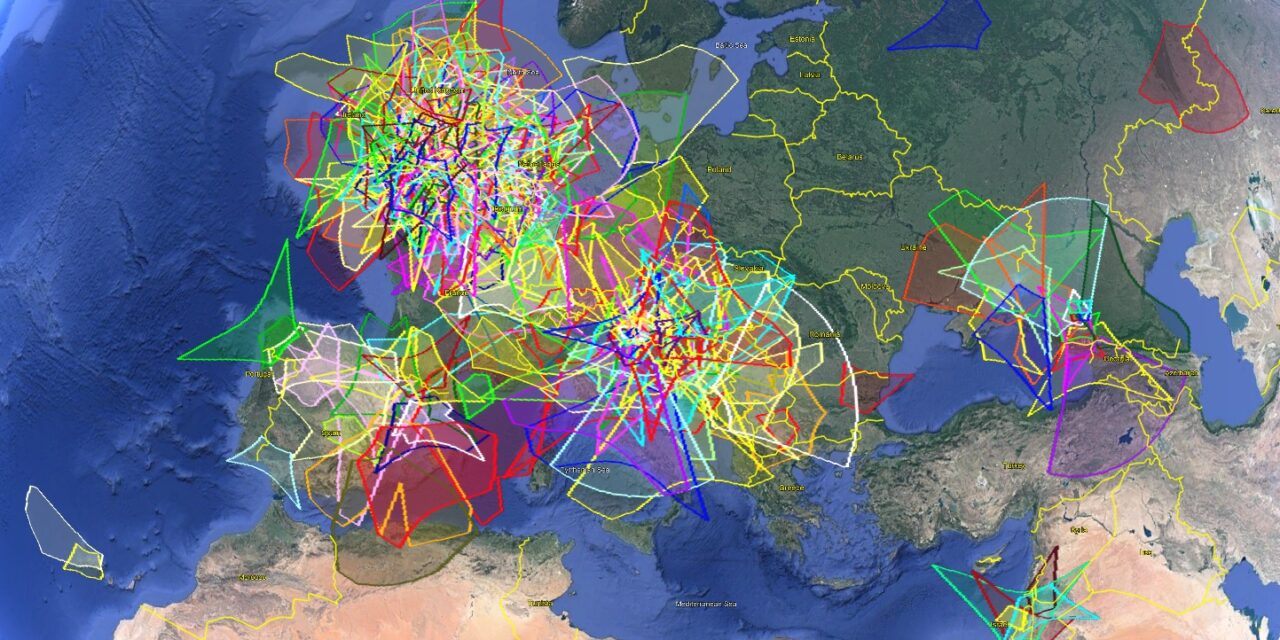

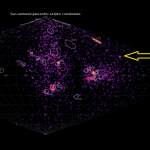
An amazing document for an amazing activity undertaken mainly by amateurs around the World.
Thank you for writing and compiling such a record.